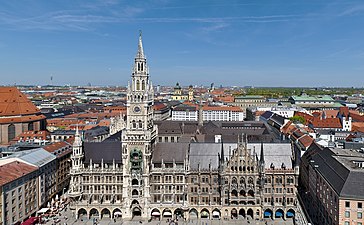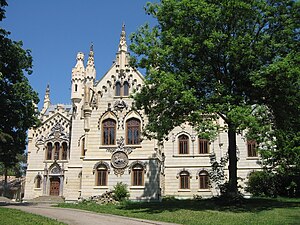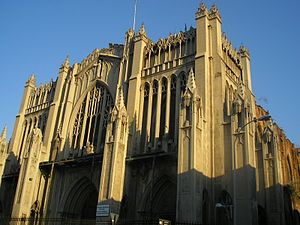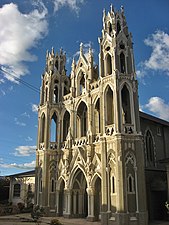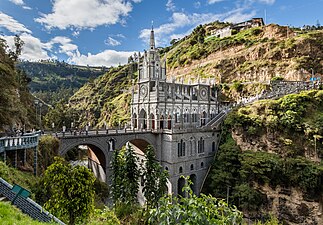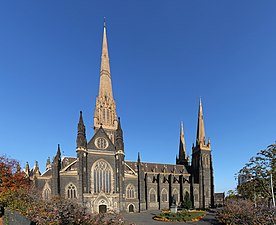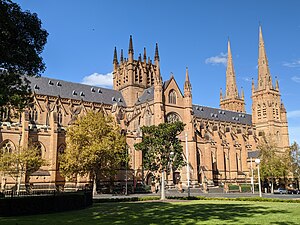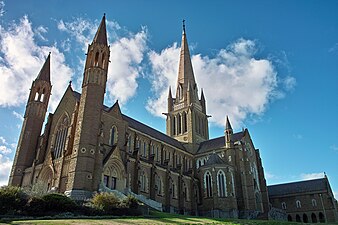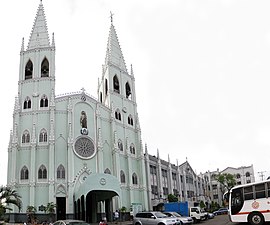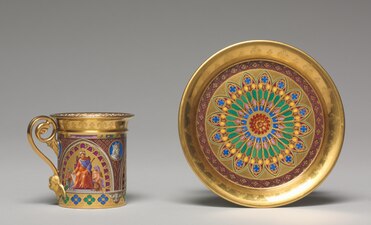Gothic Revival architecture
哥特复兴式建筑
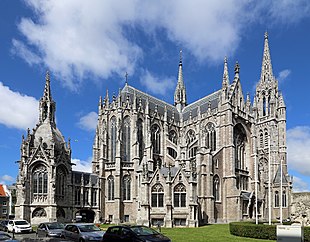
建于 1899 年至 1908 年的比利时奥斯坦德 Sint-Petrus-en-Pauluskerk。
Gothic Revival (also referred to as Victorian Gothic or neo-Gothic) is an architectural movement that after a gradual build-up beginning in the second half of the 17th century became a widespread movement in the first half of the 19th century, mostly in England. Increasingly serious and learned admirers sought to revive medieval Gothic architecture, intending to complement or even supersede the neoclassical styles prevalent at the time. Gothic Revival draws upon features of medieval examples, including decorative patterns, finials, lancet windows, and hood moulds. By the middle of the 19th century, Gothic Revival had become the pre-eminent architectural style in the Western world, only to begin to fall out of fashion in the 1880s and early 1890s.
哥特复兴(也称维多利亚哥特或新哥特)是一场建筑运动,从 17 世纪下半叶开始逐渐兴起,到 19 世纪上半叶成为一场广泛的运动,主要发生在英国。越来越多严肃而博学的崇拜者试图复兴中世纪哥特式建筑,以补充甚至取代当时流行的新古典主义风格。哥特式复兴借鉴了中世纪建筑的特点,包括装饰图案、顶饰、镶嵌窗和罩模。到 19 世纪中叶,哥特式复兴已成为西方世界最杰出的建筑风格,只是到了 19 世纪 80 年代和 90 年代初,这种风格才开始不再流行。
The Gothic Revival movement's roots are intertwined with philosophical movements associated with Catholicism and a re-awakening of high church or Anglo-Catholic belief concerned by the growth of religious nonconformism. The "Anglo-Catholic" tradition of religious belief and style became known for its intrinsic appeal in the third quarter of the 19th century. Gothic Revival architecture varied considerably in its faithfulness to both the ornamental styles and construction principles of its medieval ideal, sometimes amounting to little more than pointed window frames and touches of neo-Gothic decoration on buildings otherwise created on wholly 19th-century plans, using contemporary materials and construction methods; most notably, this involved the use of iron and, after the 1880s, steel in ways never seen in medieval exemplars.
哥特式复兴运动的根源与天主教相关的哲学运动以及因宗教不拘一格的增长而重新唤醒的高级教会或盎格鲁天主教信仰交织在一起。19 世纪第三季度,"盎格鲁-天主教 "的宗教信仰和风格传统因其固有的吸引力而闻名于世。哥特式复兴建筑在忠实于其中世纪理想的装饰风格和建造原则方面存在很大差异,有时仅仅是在完全按照 19 世纪的设计图建造的建筑物上使用尖形窗框和新哥特式装饰,并使用当代材料和建造方法;最值得注意的是,这涉及到铁的使用,以及 19 世纪 80 年代后钢的使用,这在中世纪的典范中是从未见过的。

萨凡纳圣约翰浸礼会大教堂(美国佐治亚州)
In parallel with the ascendancy of neo-Gothic styles in 19th century England, interest spread to the rest of Europe, Australia, Africa and the Americas; the 19th and early 20th centuries saw the construction of very large numbers of Gothic Revival structures worldwide. The influence of Revivalism had nevertheless peaked by the 1870s. New architectural movements, sometimes related, as in the Arts and Crafts movement, and sometimes in outright opposition, such as Modernism, gained ground, and by the 1930s the architecture of the Victorian era was generally condemned or ignored.[by whom?] The later 20th century saw a revival of interest, manifested in the United Kingdom by the establishment of the Victorian Society in 1958.
随着新哥特式风格在 19 世纪英国的兴起,欧洲其他国家、澳大利亚、非洲和美洲也对其产生了浓厚的兴趣;19 世纪和 20 世纪初,世界各地兴建了大量哥特式复兴建筑。然而,复兴主义的影响力在 19 世纪 70 年代达到了顶峰。新的建筑运动,有时是相关的,如工艺美术运动,有时是完全对立的,如现代主义,逐渐占据了上风,到 20 世纪 30 年代,维多利亚时代的建筑普遍受到谴责或被忽视。20 世纪晚期,人们对维多利亚时期建筑的兴趣有所恢复,1958 年英国成立了维多利亚协会。
Roots 根源[edit]
The rise of evangelicalism in the eighteenth and early nineteenth centuries saw in England a reaction in the high church movement which sought to emphasise the continuity between the established church and the pre-Reformation Catholic church.[1] Architecture, in the form of the Gothic Revival, became one of the main weapons in the high church's armoury. The Gothic Revival was also paralleled and supported by "medievalism", which had its roots in antiquarian concerns with survivals and curiosities. As "industrialisation" progressed, a reaction against machine production and the appearance of factories also grew. Proponents of the picturesque such as Thomas Carlyle and Augustus Pugin took a critical view of industrial society and portrayed pre-industrial medieval society as a golden age. To Pugin, Gothic architecture was infused with the Christian values that had been supplanted by classicism and were being destroyed by industrialisation.[2]
十八世纪和十九世纪初,福音派兴起,英国出现了高教会运动的反动,该运动试图强调已建立的教会与宗教改革前的天主教会之间的连续性。以哥特式复兴为形式的建筑成为高等教会的主要武器之一。与哥特式复兴并驾齐驱的还有 "中世纪主义",其根源在于古董商对遗物和奇珍异宝的关注。随着 "工业化 "的发展,人们对机器生产和工厂外观的反感也在增加。托马斯-卡莱尔(Thomas Carlyle)和奥古斯都-普金(Augustus Pugin)等风景如画的倡导者对工业社会持批判态度,并将工业化前的中世纪社会描绘成一个黄金时代。在普金看来,哥特式建筑注入了基督教价值观,而这些价值观已被古典主义所取代,并正被工业化所摧毁。 [2]
Gothic Revival also took on political connotations; with the "rational" and "radical" Neoclassical style being seen as associated with republicanism and liberalism (as evidenced by its use in the United States and to a lesser extent in Republican France), the more spiritual and traditional Gothic Revival became associated with monarchism and conservatism, which was reflected by the choice of styles for the rebuilt government centres of the British parliament's Palace of Westminster in London, the Canadian Parliament Buildings in Ottawa and the Hungarian Parliament Building in Budapest.[3]
哥特式复兴还具有政治内涵;"理性 "和 "激进 "的新古典主义风格被视为与共和主义和自由主义相关联(在美国的使用就是证明,在共和时期的法国也有较少使用),而更具精神性和传统性的哥特式复兴则与君主主义和保守主义相关联,重建后的伦敦英国议会威斯敏斯特宫、渥太华加拿大议会大厦和布达佩斯匈牙利议会大厦等政府中心的风格选择就反映了这一点。 [3]
In English literature, the architectural Gothic Revival and classical Romanticism gave rise to the Gothic novel genre, beginning with The Castle of Otranto (1764) by Horace Walpole,[4] and inspired a 19th-century genre of medieval poetry that stems from the pseudo-bardic poetry of "Ossian". Poems such as "Idylls of the King" by Alfred, Lord Tennyson recast specifically modern themes in medieval settings of Arthurian romance. In German literature, the Gothic Revival also had a grounding in literary fashions.[5]
在英国文学中,哥特式建筑复兴和古典浪漫主义催生了哥特式小说流派,从霍勒斯-沃波尔(Horace Walpole)的《奥特朗托城堡》(1764 年)开始。阿尔弗雷德-丁尼生(Alfred, Lord Tennyson)的《国王田园诗》(Idylls of the King)等诗歌以中世纪亚瑟王的浪漫故事为背景,重塑了具体的现代主题。在德国文学中,哥特式复兴也以文学时尚为基础。 [5]
Survival and revival 生存与复兴[edit]
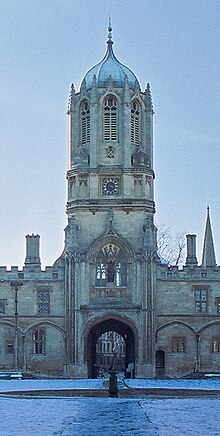
牛津汤姆塔,由克里斯托弗-雷恩爵士(Sir Christopher Wren)于 1681-1682 年设计,与都铎王朝的环境相匹配
Gothic architecture began at the Basilica of Saint Denis near Paris, and the Cathedral of Sens in 1140[6] and ended with a last flourish in the early 16th century with buildings like Henry VII's Chapel at Westminster.[7] However, Gothic architecture did not die out completely in the 16th century but instead lingered in on-going cathedral-building projects; at Oxford and Cambridge Universities, and in the construction of churches in increasingly isolated rural districts of England, France, Germany, the Polish–Lithuanian Commonwealth and in Spain.[8]
哥特式建筑始于巴黎附近的圣德尼大教堂和 1140 年的桑斯大教堂 [6] ,在 16 世纪初以威斯敏斯特的亨利七世礼拜堂等建筑的最后一次兴盛而告终。 [7] 然而,哥特式建筑并没有在 16 世纪完全消亡,而是在牛津大学和剑桥大学持续进行的大教堂建设项目中,以及在英格兰、法国、德国、波兰-立陶宛联邦和西班牙日益偏僻的农村地区建造教堂的过程中,哥特式建筑仍在徘徊。 [8]
Britain and Ireland 英国和爱尔兰[edit]
St Columb's Cathedral, in Derry, may be considered 'Gothic Survival', as it was completed in 1633 in a Perpendicular Gothic style.[9] Similarly, Gothic architecture survived in some urban settings during the later 17th century, as shown in Oxford and Cambridge, where some additions and repairs to Gothic buildings were considered to be more in keeping with the style of the original structures than contemporary Baroque.[10]
位于德里的圣哥伦布大教堂可被视为 "哥特式幸存建筑",因为它于 1633 年竣工,采用的是垂直哥特式风格。 [9] 同样,哥特式建筑在 17 世纪晚期的一些城市环境中也得以保存,如牛津和剑桥,在那里,对哥特式建筑的一些增建和修缮被认为比当代巴洛克风格更符合原有建筑的风格。 [10]
In contrast, Dromore Cathedral, built in 1660/1661, immediately after the end of the Protectorate, revived Early English forms, demonstrating the restitution of the monarchy and claiming Ireland for the English crown.[11] At the same time, the Great Hall of Lambeth Palace, that had been despoiled by the Puritans, was rebuilt in a mixture of Baroque and older Gothic forms, demonstrating the restitution of the Anglican Church.[12] These two buildings can be said to herald the onset of Gothic Revival architecture, several decades before it became mainstream. Sir Christopher Wren's Tom Tower for Christ Church, University of Oxford, consciously set out to imitate Cardinal Wolsey's architectural style. Writing to Dean Fell in 1681, he noted; "I resolved it ought to be Gothic to agree with the Founder's work", adding that to do otherwise would lead to "an unhandsome medley". Pevsner suggests that he succeeded "to the extent that innocent visitors never notice the difference". It was followed in 1697–1704 by the rebuilding of Collegiate Church of St Mary in Warwick as a stone-vaulted hall church, whereas the burnt church had been a basilica with timbered roofs. Also in Warwickshire, in 1729/30, the nave and aisles of the church of St Nicholas at Alcester were rebuilt by Edward and Thomas Woodward, the exterior in Gothic forms but with a Neoclassical interior.[13] At the same time, 1722–1746, Nicholas Hawksmoor added the west towers to Westminster Abbey, which made him a pioneer of Gothic Revival completions of medieval buildings,[14] which from the late 19th century were increasingly disapproved of, although work in this style continued into the 20th century.[15] Back in Oxford, the redecoration of the dining hall at University College between 1766 and 1768 has been described as "the first major example of the Gothic Revival style in Oxford".[a][17]
与此形成鲜明对比的是,1660/1661 年保护国结束后立即修建的德洛摩尔大教堂(Dromore Cathedral)恢复了早期英国风格,显示了君主制的恢复,并将爱尔兰归还给英国王室。与此同时,被清教徒毁坏的兰贝斯宫大礼堂以巴洛克风格和古老的哥特式风格混合的形式进行了重建,展示了英国圣公会的复兴。 [12] 这两座建筑可以说是哥特复兴建筑的开端,比其成为主流早了几十年。克里斯托弗-雷恩爵士为牛津大学基督教堂设计的汤姆塔有意识地模仿了红衣主教沃尔西的建筑风格。1681 年,他在写给费尔院长的信中写道:"我决定将其设计成哥特式,以便与创始人的作品保持一致",并补充说,如果不这样做,就会导致 "一种不体面的混杂"。佩夫斯纳认为他成功了,"以至于无辜的参观者从未注意到其中的差别"。1697-1704 年,沃里克的圣玛丽教堂重建为石拱大厅教堂,而被烧毁的教堂则是木质屋顶的大教堂。同样是在沃里克郡,1729/30 年,爱德华和托马斯-伍德沃德重建了阿尔斯特的圣尼古拉斯教堂的中殿和过道,外部采用哥特式形式,内部则是新古典主义风格。 [13] 同时,尼古拉斯-霍克斯莫尔(Nicholas Hawksmoor)于 1722-1746 年为威斯敏斯特大教堂加建了西塔,这使他成为哥特复兴时期中世纪建筑改造的先驱。 [15] 回到牛津,1766 年至 1768 年间对大学学院餐厅的重新装修被誉为 "牛津哥特复兴风格的第一个重要典范"。 [a] [17]
Continental Europe 欧洲大陆[edit]
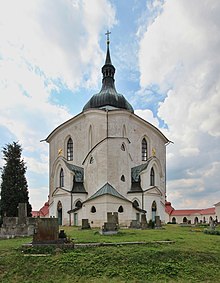
内波穆克的圣约翰朝圣教堂,捷克,历史悠久的摩拉维亚,扬-桑蒂尼-艾谢尔(约 1720 年
Throughout France in the 16th and 17th centuries, churches such as St-Eustache (1532–1640, façade 1754) in Paris and Orléans Cathedral (1601–1829) continued to be built following Gothic principles (structure of the buildings, application of tracery) with some little changes like the use of round arches instead of pointed arches and the application of some Classical details, until the arrival of Baroque architecture.[18]
16 世纪和 17 世纪,在整个法国,巴黎的圣-尤斯塔克教堂(1532-1640 年,正面 1754 年)和奥尔良大教堂(1601-1829 年)等教堂的建造一直遵循哥特式原则(建筑结构、装饰图案的应用),只是做了一些小改动,如用圆拱代替尖拱,并应用了一些古典细节,直到巴洛克建筑的到来。 [18]
In Bologna, in 1646, the Baroque architect Carlo Rainaldi constructed Gothic vaults (completed 1658) for the Basilica of San Petronio in Bologna, which had been under construction since 1390; there, the Gothic context of the structure overrode considerations of the current architectural mode. Similarly, in St. Salvator's Cathedral of Bruges, the timbered medieval vaults of nave and choir were replaced by "Gothic" stone vaults in 1635 resp. 1738/39. Guarino Guarini, a 17th-century Theatine monk active primarily in Turin, recognized the "Gothic order" as one of the primary systems of architecture and made use of it in his practice.[19]
在博洛尼亚,1646 年,巴洛克建筑师卡罗-雷纳尔迪(Carlo Rainaldi)为博洛尼亚的圣佩特罗尼奥大教堂建造了哥特式拱顶(1658 年完工),该教堂自 1390 年开始建造;在那里,哥特式建筑的背景压倒了对当前建筑模式的考虑。同样,在布鲁日的圣萨尔瓦多大教堂,中殿和唱诗班的木质中世纪拱顶在 1635 年和 1738/39 年分别被 "哥特式 "石质拱顶取代。瓜里诺-瓜里尼(Guarino Guarini)是 17 世纪主要活跃在都灵的 Theatine 修道士,他认为 "哥特式秩序 "是建筑的主要体系之一,并在实践中加以运用。 [19]
Even in Central Europe of the late 17th and 18th centuries, where Baroque dominated, some architects used elements of the Gothic style. The most important example is Jan Santini Aichel, whose Pilgrimage Church of Saint John of Nepomuk in Žďár nad Sázavou, Czech Republic, represents a peculiar and creative synthesis of Baroque and Gothic.[20] An example of another and less striking use of the Gothic style in the time is the Basilica of Our Lady of Hungary in Márianosztra, Hungary, whose choir (adjacent to a Baroque nave) was long considered authentically Gothic, because the 18th-century architect used medieval shapes to emphasize the continuity of the monastic community with its 14th-century founders.[21]
即使在巴洛克风格占主导地位的 17 世纪末和 18 世纪的中欧,一些建筑师也使用了哥特式风格的元素。最重要的例子是扬-桑蒂尼-艾谢尔,他位于捷克共和国Žďár nad Sázavou的内波穆克圣约翰朝圣教堂是巴洛克和哥特式风格独特而富有创造性的综合体。该教堂的唱诗班(毗邻巴洛克式中殿)一直被认为是真正的哥特式建筑,因为 18 世纪的建筑师使用了中世纪的造型来强调修道院社区与其 14 世纪创始人的延续性。 [21]
Romantic challenges 浪漫挑战[edit]
During the mid-18th century rise of Romanticism, an increased interest and awareness of the Middle Ages among influential connoisseurs created a more appreciative approach to selected medieval arts, beginning with church architecture, the tomb monuments of royal and noble personages, stained glass, and late Gothic illuminated manuscripts. Other Gothic arts, such as tapestries and metalwork, continued to be disregarded as barbaric and crude, however sentimental and nationalist associations with historical figures were as strong in this early revival as purely aesthetic concerns.[22]
在 18 世纪中叶浪漫主义兴起期间,有影响力的鉴赏家对中世纪的兴趣和认识不断提高,从而对部分中世纪艺术产生了更多的欣赏态度,首先是教堂建筑、王室和贵族的墓碑、彩色玻璃和晚期哥特式印刷手稿。其他哥特式艺术,如挂毯和金属制品,仍然被视为野蛮和粗陋,但在这一早期复兴中,对历史人物的情感和民族主义联想与纯粹的审美关注一样强烈。 [22]
伦敦特威克纳姆的草莓山别墅;1749 年由霍勒斯-沃波尔(1717-1797 年)建造。作为 "英国哥特式复兴的开山之作",它确立了 "草莓山哥特式 "风格 [23] 。
German Romanticists (including philosopher and writer Goethe and architect Karl Friedrich Schinkel), began to appreciate the picturesque character of ruins—"picturesque" becoming a new aesthetic quality—and those mellowing effects of time that the Japanese call wabi-sabi and that Horace Walpole independently admired, mildly tongue-in-cheek, as "the true rust of the Barons' wars".[b][24] The "Gothick" details of Walpole's Twickenham villa, Strawberry Hill House begun in 1749, appealed to the rococo tastes of the time,[c][26] and were fairly quickly followed by James Talbot at Lacock Abbey, Wiltshire.[27] By the 1770s, thoroughly neoclassical architects such as Robert Adam and James Wyatt were prepared to provide Gothic details in drawing-rooms, libraries and chapels and, for William Beckford at Fonthill in Wiltshire, a complete romantic vision of a Gothic abbey.[d][30]
德国浪漫主义者(包括哲学家、作家歌德和建筑师卡尔-弗里德里希-申克尔)开始欣赏废墟如画的特征--"如画 "成为一种新的美学特质--以及那些被日本人称为 "佗"(wabi-sabi)、被霍勒斯-沃波尔(Horace Walpole)以调侃的口吻赞美为 "男爵战争的真正锈迹 "的时间醇化效果。 [b] [24] 1749 年,沃波尔在特威克纳姆的别墅--草莓山庄(Strawberry Hill House)开始建造,其 "哥特式 "细节迎合了当时洛可可式的品味, [c] [26] 詹姆斯-塔尔博特(James Talbot)也很快在威尔特郡的拉科克修道院(Lacock Abbey)建造了自己的别墅。 [27] 到了 17 世纪 70 年代,罗伯特-亚当(Robert Adam)和詹姆斯-怀亚特(James Wyatt)等彻底的新古典主义建筑师准备在客厅、图书馆和小礼拜堂中提供哥特式细节,而威廉-贝克福德(William Beckford)在威尔特郡的丰瑟尔(Fonthill)则完全是对哥特式修道院的浪漫想象。 [d] [30]
Some of the earliest architectural examples of the revived are found in Scotland. Inveraray Castle, constructed from 1746 for the Duke of Argyll, with design input from William Adam, displays the incorporation of turrets.[e] The architectural historian John Gifford writes that the castellations were the "symbolic assertion of the still quasi-feudal power [the duke] exercised over the inhabitants within his heritable jurisdictions".[32] Most buildings were still largely in the established Palladian style, but some houses incorporated external features of the Scots baronial style. Robert Adam's houses in this style include Mellerstain[33] and Wedderburn[34] in Berwickshire and Seton Castle in East Lothian,[35] but it is most clearly seen at Culzean Castle, Ayrshire, remodelled by Adam from 1777.[36] The eccentric landscape designer Batty Langley even attempted to "improve" Gothic forms by giving them classical proportions.[37]
苏格兰有一些最早的复兴建筑实例。1746 年,威廉-亚当(William Adam)为阿盖尔公爵(Duke of Argyll)建造了因弗拉雷城堡(Inveraray Castle),该城堡采用了炮塔设计。建筑历史学家约翰-吉福德(John Gifford)写道,炮楼是"[公爵]对其可继承辖区内的居民行使的仍然是准封建权力的象征性宣示"。 [32] 大多数建筑在很大程度上仍采用既定的帕拉第奥风格,但有些房屋的外部特征则采用了苏格兰男爵风格。罗伯特-亚当(Robert Adam)的这种风格的房屋包括伯里克郡的梅勒斯泰因(Mellerstain) [33] 和韦德伯恩(Wedderburn) [34] 以及东洛锡安的塞顿城堡(Seton Castle) [35] ,但最明显的是艾尔郡的库尔泽恩城堡(Culzean Castle),亚当于 1777 年对其进行了改造。 [36] 古怪的景观设计师巴蒂-兰利(Batty Langley)甚至试图 "改进 "哥特式建筑的形式,赋予其古典主义的比例。 [37]
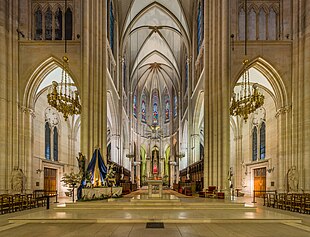
法国巴黎圣克洛蒂尔德圣殿大教堂
A younger generation, taking Gothic architecture more seriously, provided the readership for John Britton's series Architectural Antiquities of Great Britain, which began appearing in 1807.[38] In 1817, Thomas Rickman wrote an Attempt... to name and define the sequence of Gothic styles in English ecclesiastical architecture, "a text-book for the architectural student". Its long antique title is descriptive: Attempt to discriminate the styles of English architecture from the Conquest to the Reformation; preceded by a sketch of the Grecian and Roman orders, with notices of nearly five hundred English buildings. The categories he used were Norman, Early English, Decorated, and Perpendicular. It went through numerous editions, was still being republished by 1881, and has been reissued in the 21st century.[f][40]
年轻一代对哥特式建筑更加重视,为约翰-布里顿的《大不列颠建筑古迹》系列提供了读者,该书于 1807 年开始出版。 [38] 1817 年,托马斯-里克曼撰写了《尝试......命名和定义英国教会建筑的哥特式风格序列》,这是一本 "建筑系学生的教科书"。其古色古香的长标题具有描述性:试图辨别从征服时期到宗教改革时期的英国建筑风格;前面是希腊和罗马风格的概述,并附有近五百幢英国建筑的说明。他使用的分类是诺曼式、早期英国式、装饰式和垂直式。该书历经多个版本,到 1881 年仍在重新出版,并在 21 世纪再版。 [f] [40]
The most common use for Gothic Revival architecture was in the building of churches. Major examples of Gothic cathedrals in the U.S. include the cathedrals of St. John the Divine and St. Patrick in New York City and the Washington National Cathedral on Mount St. Alban in northwest Washington, D.C. One of the biggest churches in Gothic Revival style in Canada is the Basilica of Our Lady Immaculate in Ontario.[41]
哥特复兴式建筑最常见的用途是建造教堂。美国哥特式大教堂的主要实例包括纽约市的圣约翰大教堂和圣帕特里克大教堂,以及位于华盛顿特区西北部圣阿尔班山上的华盛顿国家大教堂。 [41]
Gothic Revival architecture remained one of the most popular and long-lived of the many revival styles of architecture. Although it began to lose force and popularity after the third quarter of the 19th century in commercial, residential and industrial fields, some buildings such as churches, schools, colleges and universities were still constructed in the Gothic style, often known as "Collegiate Gothic", which remained popular in England, Canada and in the United States until well into the early to mid-20th century. Only when new materials, like steel and glass along with concern for function in everyday working life and saving space in the cities, meaning the need to build up instead of out, began to take hold did the Gothic Revival start to disappear from popular building requests.[42]
在众多复兴建筑风格中,哥特式复兴建筑一直是最受欢迎和最长寿的建筑之一。虽然在 19 世纪第三季度之后,哥特式建筑风格在商业、住宅和工业领域的影响力和受欢迎程度开始下降,但一些建筑,如教堂、学校、学院和大学,仍然采用哥特式建筑风格(通常被称为 "学院哥特式"),这种风格在英国、加拿大和美国一直流行到 20 世纪早期和中期。直到钢材和玻璃等新材料的出现,以及人们开始关注日常工作生活中的功能和节省城市空间,即需要向上而不是向外建造,哥特复兴风格才开始从流行的建筑要求中消失。 [42]
Gothic Revival in the other decorative arts
其他装饰艺术中的哥特式复兴[edit]
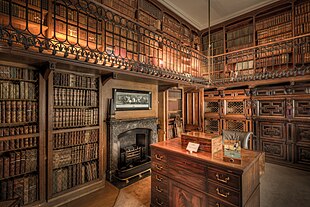
阿伯兹福德的书房是为沃尔特-司各特爵士建造的,他的小说使中世纪流行起来,而哥特式复兴正是从中世纪汲取灵感的
The revived Gothic style was not limited to architecture. Classical Gothic buildings of the 12th to 16th Centuries were a source of inspiration to 19th-century designers in numerous fields of work. Architectural elements such as pointed arches, steep-sloping roofs and fancy carvings like lace and lattice work were applied to a wide range of Gothic Revival objects. Some examples of Gothic Revival influence can be found in heraldic motifs in coats of arms, furniture with elaborate painted scenes like the whimsical Gothic detailing in English furniture is traceable as far back as Lady Pomfret's house in Arlington Street, London (1740s),[43] and Gothic fretwork in chairbacks and glazing patterns of bookcases is a familiar feature of Chippendale's Director (1754, 1762), where, for example, the three-part bookcase employs Gothic details with Rococo profusion, on a symmetrical form.[44][45] Abbotsford in the Scottish Borders, rebuilt from 1816 by Sir Walter Scott and paid for by the profits from his hugely successful, historical novels, exemplifies the "Regency Gothic" style.[g][47] Gothic Revival also includes the reintroduction of medieval clothes and dances in historical re-enactments staged especially in the second part of the 19th century, although one of the first, the Eglinton Tournament of 1839, remains the most famous.[48]
复兴的哥特式风格并不局限于建筑。12 至 16 世纪的古典哥特式建筑为 19 世纪众多领域的设计师带来了灵感。尖拱门、陡坡屋顶等建筑元素以及蕾丝和花格等花式雕刻被广泛应用于哥特式复兴风格的物品中。哥特式复兴影响的一些例子可见于纹章中的纹章图案、带有精致彩绘场景的家具,如英国家具中异想天开的哥特式细节,最早可追溯到庞弗雷特夫人在阿灵顿街的房子、伦敦(1740 年代), [43] 而椅背上的哥特式镂空和书柜上的釉面图案是奇彭代尔的作品 Director(1754 年,1762 年)中常见的特征,例如,三段式书柜在对称的造型上运用了哥特式细节和洛可可式的繁复装饰。 [44] [45] 苏格兰边界地区的阿伯兹福德,由沃尔特-司各特爵士从 1816 年开始重建,资金来自他大获成功的历史小说,是 "摄政时期哥特式 "风格的典范。 [g] [47] 哥特式复兴还包括在重现历史的活动中重新采用中世纪的服装和舞蹈,尤其是在 19 世纪下半叶,尽管最早的活动之一,即 1839 年的埃格林顿锦标赛,仍然是最著名的活动。 [48]
During the Bourbon Restoration in France (1814–1830) and the Louis-Philippe period (1830–1848), Gothic Revival motifs start to appear, together with revivals of the Renaissance and of Rococo. During these two periods, the vogue for medieval things led craftsmen to adopt Gothic decorative motifs in their work, such as bell turrets, lancet arches, trefoils, Gothic tracery and rose windows. This style was also known as "Cathedral style" ("À la catédrale").[49][50]
在法国波旁王朝复辟时期(1814-1830 年)和路易-菲利普时期(1830-1848 年),哥特式复兴图案开始出现,同时复兴的还有文艺复兴和洛可可风格。在这两个时期,对中世纪事物的追捧使得工匠们在他们的作品中采用哥特式装饰图案,如钟楼、长方形拱门、三叶形装饰、哥特式窗花和玫瑰窗。这种风格也被称为 "大教堂风格"("À la catédrale")。 [49] [50]
By the mid-19th century, Gothic traceries and niches could be inexpensively re-created in wallpaper, and Gothic blind arcading could decorate a ceramic pitcher. Writing in 1857, J. G. Crace, an influential decorator from a family of influential interior designers, expressed his preference for the Gothic style: "In my opinion there is no quality of lightness, elegance, richness or beauty possessed by any other style... [or] in which the principles of sound construction can be so well carried out".[51] The illustrated catalogue for the Great Exhibition of 1851 is replete with Gothic detail, from lacemaking and carpet designs to heavy machinery. Nikolaus Pevsner's volume on the exhibits at the Great Exhibition, High Victorian Design published in 1951, was an important contribution to the academic study of Victorian taste and an early indicator of the later 20th century rehabilitation of Victorian architecture and the objects with which they decorated their buildings.[52]
到了 19 世纪中叶,哥特式的桁架和壁龛可以用壁纸廉价地再现,哥特式的盲拱可以装饰陶瓷投手。1857 年,出身于室内设计师世家、颇具影响力的装饰设计师 J. G. Crace 写道,他对哥特式风格情有独钟:"在我看来,任何其他风格都不具备轻盈、优雅、丰富或美丽的品质......在我看来,没有任何一种风格具有如此轻盈、优雅、丰富或美丽的特质,[或]能够如此完美地贯彻合理的建筑原则"。 [51] 1851 年大博览会的图录充满了哥特式细节,从花边和地毯设计到重型机械。尼古劳斯-佩夫斯纳(Nikolaus Pevsner)于 1951 年出版了一本关于大博览会展品的著作《维多利亚时代的高级设计》(High Victorian Design),这是对维多利亚时代品味的学术研究的重要贡献,也是 20 世纪后期维多利亚时代建筑和建筑装饰品复兴的早期标志。 [52]
In 1847, eight thousand British crown coins were minted in proof condition with the design using an ornate reverse in keeping with the revived style. Considered by collectors to be particularly beautiful, they are known as 'Gothic crowns'. The design was repeated in 1853, again in proof. A similar two shilling coin, the 'Gothic florin' was minted for circulation from 1851 to 1887.[53][54]
1847 年,英国铸造了八千枚样币,其背面设计华丽,符合当时的复兴风格。收藏者认为它们特别精美,被称为 "哥特式皇冠"。1853 年,该设计再次以样币形式出现。类似的两先令硬币--"哥特式弗罗林 "于 1851 年至 1887 年间铸造流通。 [53] [54]
Romanticism and nationalism
浪漫主义与民族主义[edit]

法国鲁昂议会大厦的哥特式外墙,建于 1499 年至 1508 年之间,后来在 19 世纪激发了新哥特式建筑的复兴。
French neo-Gothic had its roots in the French medieval Gothic architecture, where it was created in the 12th century. Gothic architecture was sometimes known during the medieval period as the "Opus Francigenum", (the "French Art"). French scholar Alexandre de Laborde wrote in 1816 that "Gothic architecture has beauties of its own",[55] which marked the beginning of the Gothic Revival in France. Starting in 1828, Alexandre Brogniart, the director of the Sèvres porcelain manufactory, produced fired enamel paintings on large panes of plate glass, for King Louis-Philippe's Chapelle royale de Dreux, an important early French commission in Gothic taste,[56] preceded mainly by some Gothic features in a few jardins paysagers.[57]
法国新哥特式建筑源于法国中世纪哥特式建筑,产生于 12 世纪。哥特式建筑在中世纪时期有时被称为 "法兰西艺术"(Opus Francigenum)。法国学者亚历山大-德-拉博德(Alexandre de Laborde)在 1816 年写道:"哥特式建筑有其自身的美", [55] 这标志着哥特式建筑复兴运动在法国的开始。从 1828 年开始,塞夫勒瓷器厂厂长亚历山大-布罗尼亚尔(Alexandre Brogniart)为路易-菲利普国王的德勒皇家礼拜堂在大玻璃板上制作了烧制的珐琅画,这是法国早期哥特式风格的重要作品, [56] 在此之前,主要是一些私人花园中的哥特式建筑。 [57]
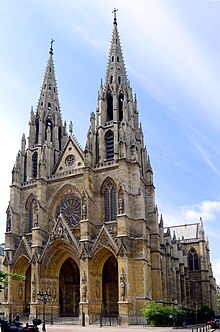
圣克罗蒂尔德大教堂(Sainte-Clotilde Basilica),1857 年建成,巴黎
The French Gothic Revival was set on more sound intellectual footings by a pioneer, Arcisse de Caumont, who founded the Societé des Antiquaires de Normandie at a time when antiquaire still meant a connoisseur of antiquities, and who published his great work on architecture in French Normandy in 1830.[58] The following year Victor Hugo's historical romance novel The Hunchback of Notre-Dame appeared, in which the great Gothic cathedral of Paris was at once a setting and a protagonist in a hugely popular work of fiction. Hugo intended his book to awaken a concern for the surviving Gothic architecture left in Europe, however, rather than to initiate a craze for neo-Gothic in contemporary life.[59] In the same year that Notre-Dame de Paris appeared, the new restored Bourbon monarchy established an office in the Royal French Government of Inspector-General of Ancient Monuments, a post which was filled in 1833 by Prosper Mérimée, who became the secretary of a new Commission des Monuments Historiques in 1837.[60] This was the Commission that instructed Eugène Viollet-le-Duc to report on the condition of the Abbey of Vézelay in 1840.[61] Following this, Viollet le Duc set out to restore most of the symbolic buildings in France including Notre Dame de Paris,[62] Vézelay,[63] Carcassonne,[64] Roquetaillade castle,[65] Mont-Saint-Michel Abbey on its peaked coastal island,[66] Pierrefonds,[67] and the Palais des Papes in Avignon.[64] When France's first prominent neo-Gothic church[h] was built, the Basilica of Saint-Clotilde,[i] Paris, begun in 1846 and consecrated in 1857, the architect chosen was of German extraction, Franz Christian Gau, (1790–1853); the design was significantly modified by Gau's assistant, Théodore Ballu, in the later stages, to produce the pair of flèches that crown the west end.[70]
法国哥特式复兴的先驱阿西斯-德-考蒙(Arcisse de Caumont)为这一复兴奠定了坚实的思想基础,他成立了诺曼底古董商协会,当时古董商还是指古董鉴赏家,他于 1830 年出版了关于法国诺曼底建筑的巨著。次年,维克多-雨果的历史爱情小说《圣母院的驼背》问世,在这部广受欢迎的小说中,伟大的哥特式巴黎大教堂既是背景,也是主角。不过,雨果希望通过这本书唤起人们对欧洲现存哥特式建筑的关注,而不是在当代生活中掀起一股新哥特式热潮。 [59] 在《巴黎圣母院》问世的同一年,新复辟的波旁王朝在法国皇家政府中设立了一个古迹监察长的职位,这个职位于 1833 年由普罗斯珀-梅里美(Prosper Mérimée)担任,他于 1837 年成为新成立的历史古迹委员会的秘书。 [60] 1840 年,委员会委托欧仁-维奥莱特-勒杜克(Eugène Viollet-le-Duc)就韦泽莱修道院的状况提出报告。 [61] 此后,维奥莱特-勒杜克着手修复了法国大部分具有象征意义的建筑,包括巴黎圣母院、 [62] 韦兹莱、 [63] 卡尔卡松、 [64] 罗克塔亚德城堡、 [65] 位于尖顶海岸岛上的圣米歇尔山修道院、 [66] 皮埃尔丰、 [67] 以及阿维尼翁的教皇宫。 法国第一座著名的新哥特式教堂 [h] ,即巴黎的圣克洛蒂尔德大教堂 [i] ,于 1846 年动工,1857 年落成,当时选用的建筑师是德国人弗朗茨-克里斯蒂安-高(Franz Christian Gau,1790-1853 年)。 [70]

1900 年左右,立陶宛取消了修建新天主教堂的禁令,教堂建设在立陶宛各地重新兴起,例如什韦克什纳的圣约翰使徒教堂。
In Germany, there was a renewal of interest in the completion of Cologne Cathedral. Begun in 1248, it was still unfinished at the time of the revival. The 1820s "Romantic" movement brought a new appreciation of the building, and construction work began once more in 1842, marking a German return for Gothic architecture. St. Vitus Cathedral in Prague, begun in 1344, was also completed in the mid-19th and early 20th centuries.[71] The importance of the Cologne completion project in German-speaking lands has been explored by Michael J. Lewis, "The Politics of the German Gothic Revival: August Reichensperger". Reichensperger was himself in no doubt as to the cathedral's central position in Germanic culture; "Cologne Cathedral is German to the core, it is a national monument in the fullest sense of the word, and probably the most splendid monument to be handed down to us from the past".[72]
在德国,人们对科隆大教堂的完工重新产生了兴趣。科隆大教堂始建于 1248 年,在复兴时期仍未完工。19 世纪 20 年代的 "浪漫主义 "运动使人们重新认识了这座建筑,并于 1842 年再次动工,标志着德国对哥特式建筑的回归。始建于 1344 年的布拉格圣维特大教堂也于 19 世纪中叶和 20 世纪初完工。迈克尔-J-刘易斯(Michael J. Lewis)在《德国哥特式复兴的政治:奥古斯特-莱辛斯佩尔格》一文中探讨了科隆大教堂完工项目在德语区的重要性。莱辛斯佩尔格本人对科隆大教堂在日耳曼文化中的核心地位深信不疑:"科隆大教堂的核心是日耳曼,它是一个最完整意义上的国家纪念碑,可能是过去流传给我们的最辉煌的纪念碑"。 [72]
Because of Romantic nationalism in the early 19th century, the Germans, French and English all claimed the original Gothic architecture of the 12th century era as originating in their own country. The English boldly coined the term "Early English" for "Gothic", a term that implied Gothic architecture was an English creation. In his 1832 edition of Notre Dame de Paris, author Victor Hugo said "Let us inspire in the nation, if it is possible, love for the national architecture", implying that "Gothic" is France's national heritage. In Germany, with the completion of Cologne Cathedral in the 1880s, at the time its summit was the world's tallest building, the cathedral was seen as the height of Gothic architecture.[73] Other major completions of Gothic cathedrals were of Regensburger Dom (with twin spires completed from 1869 to 1872),[74] Ulm Münster (with a 161-meter tower from 1890)[75] and St. Vitus Cathedral in Prague (1844–1929).[76]
由于 19 世纪初的浪漫主义民族主义,德国人、法国人和英国人都声称 12 世纪的哥特式建筑起源于自己的国家。英国人大胆地为 "哥特式 "创造了 "早期英国式 "一词,暗示哥特式建筑是英国人的创造。作家维克多-雨果在 1832 年出版的《巴黎圣母院》中说:"如果可能的话,让我们在国民中激发对民族建筑的热爱",暗示 "哥特式 "是法国的国粹。在德国,随着科隆大教堂在 19 世纪 80 年代的落成,当时它的顶峰是世界上最高的建筑,科隆大教堂被视为哥特式建筑的高峰。 [73] 其他建成的哥特式大教堂还有雷根斯堡大教堂(1869 年至 1872 年建成双尖塔)、 [74] 乌尔姆明斯特大教堂(1890 年建成 161 米高的塔楼) [75] 和布拉格圣维特大教堂(1844-1929 年)。 [76]
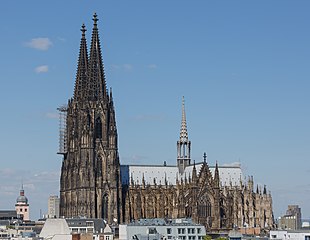
科隆大教堂,虽然始建于 1248 年,但最终于 1880 年竣工
In Belgium, a 15th-century church in Ostend burned down in 1896. King Leopold II funded its replacement, the Saint Peter's and Saint Paul's Church, a cathedral-scale design which drew inspiration from the neo-Gothic Votive Church in Vienna and Cologne Cathedral.[77] In Mechelen, the largely unfinished building drawn in 1526 as the seat of the Great Council of The Netherlands, was not actually built until the early 20th century, although it closely followed Rombout II Keldermans's Brabantine Gothic design, and became the 'new' north wing of the City Hall.[78][79] In Florence, the Duomo's temporary façade erected for the Medici-House of Lorraine nuptials in 1588–1589, was dismantled, and the west end of the cathedral stood bare again until 1864, when a competition was held to design a new façade suitable to Arnolfo di Cambio's original structure and the fine campanile next to it. This competition was won by Emilio De Fabris, and so work on his polychrome design and panels of mosaic was begun in 1876 and completed by 1887, creating the Neo-Gothic western façade.[80]
在比利时,奥斯坦德一座建于 15 世纪的教堂于 1896 年被烧毁。国王利奥波德二世出资建造了圣彼得和圣保罗教堂来取代它,这座教堂的规模设计借鉴了维也纳新哥特式圣母教堂和科隆大教堂。 [77] 在梅赫伦,1526 年作为荷兰大议会所在地的建筑基本未完工,直到 20 世纪初才真正建成,尽管它严格遵循了隆布特二世-凯尔德曼斯的布拉班特哥特式设计,并成为市政厅的 "新 "北翼。 [78] [79] 在佛罗伦萨,为 1588-1589 年美第奇-洛林家族婚礼而临时搭建的大教堂外墙被拆除,大教堂的西端再次光秃秃地矗立着,直到 1864 年才举办了一次竞赛,为阿诺尔弗-迪-坎皮奥的原建筑和旁边的精美钟楼设计一个新的外墙。埃米利奥-德-法布里斯在比赛中胜出,因此他的多色设计和马赛克镶板工程于 1876 年开工,1887 年竣工,创造了新哥特式西立面。 [80]
Eastern Europe also saw much Revival construction; in addition to the Hungarian Parliament Building in Budapest,[3] the Bulgarian National Revival saw the introduction of Gothic Revival elements into its vernacular ecclesiastical and residential architecture. The largest project of the Slavine School is the Lopushna Monastery cathedral (1850–1853), though later churches such as Saint George's Church, Gavril Genovo display more prominent vernacular Gothic Revival features.[81]
东欧也出现了许多复兴建筑;除了布达佩斯的匈牙利议会大厦, [3] 保加利亚的民族复兴运动也将哥特复兴元素引入了当地的教堂和住宅建筑中。斯拉夫学派最大的项目是洛普什纳修道院大教堂(1850-1853 年),尽管后来的圣乔治教堂、加夫里尔-热诺沃等教堂显示出更突出的本土哥特式复兴特征。 [81]

从渥太华河上俯瞰加拿大国会大厦,包括后面的哥特复兴式图书馆,建于 1859 年至 1876 年之间
In Scotland, while a similar Gothic style to that used further south in England was adopted by figures including Frederick Thomas Pilkington (1832–1898)[82] in secular architecture it was marked by the re-adoption of the Scots baronial style.[83] Important for the adoption of the style in the early 19th century was Abbotsford, which became a model for the modern revival of the baronial style.[84] Common features borrowed from 16th- and 17th-century houses included battlemented gateways, crow-stepped gables, pointed turrets and machicolations. The style was popular across Scotland and was applied to many relatively modest dwellings by architects such as William Burn (1789–1870), David Bryce (1803–1876),[85] Edward Blore (1787–1879), Edward Calvert (c. 1847–1914) and Robert Stodart Lorimer (1864–1929) and in urban contexts, including the building of Cockburn Street in Edinburgh (from the 1850s) as well as the National Wallace Monument at Stirling (1859–1869).[86] The reconstruction of Balmoral Castle as a baronial palace and its adoption as a royal retreat from 1855 to 1858 confirmed the popularity of the style.[84]
在苏格兰,虽然弗雷德里克-托马斯-皮尔金顿(1832-1898 年)等人采用了与英格兰南部类似的哥特式风格 [82] ,但在世俗建筑中,苏格兰男爵式建筑风格的重新采用是其标志。 [83] 19 世纪初采用这种风格的重要建筑是阿伯兹福德,它成为现代男爵风格复兴的典范。 [84] 从 16 和 17 世纪的房屋中借鉴的常见特征包括雉堞式门楼、乌阶式屋檐、尖塔和机关。这种风格流行于苏格兰各地,被威廉-伯恩(William Burn,1789-1870 年)、戴维-布莱斯(David Bryce,1803-1876 年)、 [85] 爱德华-布洛尔(Edward Blore,1787-1879 年)、爱德华-卡尔弗特(Edward Calvert,约 1847-1914 年)和罗伯特-斯托达特-洛里默(Robert Stodart Lorimer,1864-1929 年)等建筑师应用于许多相对简朴的住宅和城市建筑中,包括爱丁堡的科伯恩街建筑(1850 年代)和斯特林的国家华莱士纪念碑(1859-1869 年)。 [86] 将巴尔莫勒尔城堡重建为一座男爵宫殿,并在 1855 年至 1858 年期间将其作为皇室休养地,证实了这种风格的受欢迎程度。 [84]
In the United States, the first "Gothic stile"[87] church (as opposed to churches with Gothic elements) was Trinity Church on the Green, New Haven, Connecticut. It was designed by Ithiel Town between 1812 and 1814, while he was building his Federalist-style Center Church, New Haven next to this radical new "Gothic-style" church. Its cornerstone was laid in 1814,[88] and it was consecrated in 1816.[89] It predates St Luke's Church, Chelsea, often said to be the first Gothic-revival church in London. Though built of trap rock stone with arched windows and doors, parts of its tower and its battlements were wood. Gothic buildings were subsequently erected by Episcopal congregations in Connecticut at St John's in Salisbury (1823), St John's in Kent (1823–1826) and St Andrew's in Marble Dale (1821–1823).[87] These were followed by Town's design for Christ Church Cathedral (Hartford, Connecticut) (1827), which incorporated Gothic elements such as buttresses into the fabric of the church. St. Paul's Episcopal Church in Troy, New York, was constructed in 1827–1828 as an exact copy of Town's design for Trinity Church, New Haven, but using local stone; due to changes in the original, St. Paul's is closer to Town's original design than Trinity itself. In the 1830s, architects began to copy specific English Gothic and Gothic Revival Churches, and these "'mature Gothic Revival' buildings made the domestic Gothic style architecture which preceded it seem primitive and old-fashioned".[90]
在美国,第一座 "哥特式风格"0#教堂(与具有哥特式元素的教堂相对)是康涅狄格州纽黑文的绿地三一教堂。该教堂由伊瑟尔-汤在 1812 年至 1814 年间设计,当时他正在这座激进的新 "哥特式 "教堂旁边建造联邦主义风格的纽黑文中心教堂。教堂于 1814 年奠基, [88] 于 1816 年祝圣。 [89] 它早于切尔西的圣路加教堂,后者通常被认为是伦敦第一座哥特式复兴教堂。虽然它是用带拱形门窗的陷岩石块建造的,但其塔楼和垛口的部分是木制的。随后,康涅狄格州的圣公会会众在索尔兹伯里的圣约翰教堂(1823 年)、肯特郡的圣约翰教堂(1823-1826 年)和大理石谷的圣安德鲁教堂(1821-1823 年)建造了哥特式建筑。在此之后,唐恩又设计了康涅狄格州哈特福德的基督教堂大教堂(1827 年),在教堂的结构中融入了扶壁等哥特式元素。纽约特洛伊的圣保罗圣公会教堂建于 1827-1828 年,完全照搬了汤恩对纽黑文三一教堂的设计,但使用了当地的石材;由于对原作进行了修改,圣保罗教堂比三一教堂本身更接近汤恩的原始设计。19 世纪 30 年代,建筑师们开始模仿特定的英国哥特式和哥特复兴式教堂,这些"'成熟的哥特复兴式'建筑使其之前的国内哥特式风格建筑显得原始而陈旧"。 [90]
There are many examples of Gothic Revival architecture in Canada. The first major structure was Notre-Dame Basilica in Montreal, Quebec, which was designed in 1824.[91] The capital, Ottawa, Ontario, was predominantly a 19th-century creation in the Gothic Revival style. The Parliament Hill buildings were the preeminent example, of which the original library survives today (after the rest was destroyed by fire in 1916).[92] Their example was followed elsewhere in the city and outlying areas, showing how popular the Gothic Revival movement had become.[41] Other examples of Canadian Gothic Revival architecture in Ottawa are the Victoria Memorial Museum, (1905–1908),[93] the Royal Canadian Mint, (1905–1908),[94] and the Connaught Building, (1913–1916),[95] all by David Ewart.[96]
加拿大有许多哥特复兴式建筑的例子。第一座大型建筑是位于魁北克蒙特利尔的圣母大教堂,设计于 1824 年。安大略省首府渥太华主要是 19 世纪哥特复兴风格的建筑。议会山(Parliament Hill)建筑是最杰出的代表,其中最初的图书馆保存至今(其余部分于 1916 年毁于火灾)。 [92] 他们的榜样在城市的其他地方和外围地区被效仿,这表明哥特复兴运动已变得多么流行。 [41] 渥太华的其他加拿大哥特式复兴建筑还有维多利亚纪念博物馆(1905-1908 年)、 [93] 加拿大皇家造币厂(1905-1908 年)、 [94] 康诺特大楼(1913-1916 年), [95] 均由大卫-尤瓦特(David Ewart)设计。 [96]
Gothic as a moral force
哥特式作为一种道德力量[edit]
Pugin and "truth" in architecture
普金与建筑中的 "真理[edit]

威斯敏斯特宫(1840-1876 年),由查尔斯-巴里和奥古斯都-普金设计
In the late 1820s, A. W. N. Pugin, still a teenager, was working for two highly visible employers, providing Gothic detailing for luxury goods.[97] For the Royal furniture makers Morel and Seddon he provided designs for redecorations for the elderly George IV at Windsor Castle in a Gothic taste suited to the setting.[j][99] For the royal silversmiths Rundell Bridge and Co., Pugin provided designs for silver from 1828, using the 14th-century Anglo-French Gothic vocabulary that he would continue to favour later in designs for the new Palace of Westminster.[100] Between 1821 and 1838 Pugin and his father published a series of volumes of architectural drawings, the first two entitled, Specimens of Gothic Architecture, and the following three, Examples of Gothic Architecture, that were to remain both in print and the standard references for Gothic Revivalists for at least the next century.[101]
19 世纪 20 年代末,还是青少年的 A. W. N. 普金为两个知名度很高的雇主工作,为奢侈品提供哥特式细节设计。 [97] 他为皇家家具制造商莫雷尔和塞登(Morel and Seddon)提供设计,为乔治四世在温莎城堡的老宅重新装饰,使其具有适合当时环境的哥特式风格。 [j] [99] 从 1828 年起,普金为皇家银匠伦德尔-布里奇和公司(Rundell Bridge and Co. [100] 1821 年至 1838 年间,普金和他的父亲出版了一系列建筑图纸,前两卷名为《哥特式建筑样本》,后三卷名为《哥特式建筑实例》,至少在下一个世纪,这些图纸仍在印刷中,并成为哥特复兴主义者的标准参考资料。 [101]
In Contrasts: or, a Parallel between the Noble Edifices of the Middle Ages, and similar Buildings of the Present Day (1836), Pugin expressed his admiration not only for medieval art but for the whole medieval ethos, suggesting that Gothic architecture was the product of a purer society. In The True Principles of Pointed or Christian Architecture (1841), he set out his "two great rules of design: 1st, that there should be no features about a building which are not necessary for convenience, construction or propriety; 2nd, that all ornament should consist of enrichment of the essential construction of the building". Urging modern craftsmen to seek to emulate the style of medieval workmanship as well as reproduce its methods, Pugin sought to reinstate Gothic as the true Christian architectural style.[102]
在《对比:或中世纪高贵建筑与当今类似建筑的对比》(1836 年)中,普金不仅表达了他对中世纪艺术的钦佩,还表达了他对整个中世纪精神的钦佩,他认为哥特式建筑是一个更纯粹社会的产物。在《尖顶建筑或基督教建筑的真正原则》(1841 年)中,他提出了自己的 "两大设计原则:第一,建筑物不应有任何非方便、建造或适当所必需的特征;第二,所有装饰都应丰富建筑物的基本构造"。普金敦促现代工匠努力模仿中世纪的工艺风格并复制其方法,他试图恢复哥特式建筑风格,使其成为真正的基督教建筑风格。 [102]
Pugin's most notable project was the Houses of Parliament in London, after its predecessor was largely destroyed in a fire in 1834.[k][104] His part in the design consisted of two campaigns, 1836–1837 and again in 1844 and 1852, with the classicist Charles Barry as his nominal superior. Pugin provided the external decoration and the interiors, while Barry designed the symmetrical layout of the building, causing Pugin to remark, "All Grecian, Sir; Tudor details on a classic body".[105]
普金最著名的作品是伦敦的议会大厦,因为其前身在 1834 年的一场大火中被烧毁了大部分。 [k] [104] 他参与了 1836 年至 1837 年以及 1844 年和 1852 年的两次设计活动,古典主义大师查尔斯-巴里(Charles Barry)是他名义上的上司。普金提供了外部装饰和内部装修,而巴里则设计了建筑的对称布局,这让普金感叹道:"都是希腊风格,先生;都铎风格的细节放在古典风格的主体上"。 [105]
Ruskin and Venetian Gothic
罗斯金与威尼斯哥特式建筑[edit]
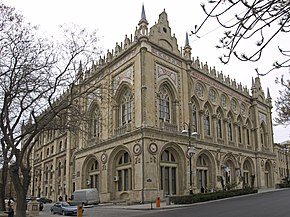
阿塞拜疆巴库的威尼斯哥特式建筑
John Ruskin supplemented Pugin's ideas in his two influential theoretical works, The Seven Lamps of Architecture (1849) and The Stones of Venice (1853). Finding his architectural ideal in Venice, Ruskin proposed that Gothic buildings excelled above all other architecture because of the "sacrifice" of the stone-carvers in intricately decorating every stone. In this, he drew a contrast between the physical and spiritual satisfaction which a medieval craftsman derived from his work, and the lack of these satisfactions afforded to modern, industrialised labour.[l][107]
约翰-罗斯金在其两部颇具影响力的理论著作《建筑的七盏灯》(The Seven Lamps of Architecture,1849 年)和《威尼斯的石头》(The Stones of Venice,1853 年)中对普金的观点进行了补充。罗斯金在威尼斯找到了自己的建筑理想,他认为哥特式建筑之所以优于其他所有建筑,是因为雕刻石匠 "牺牲 "了自己,对每块石头进行了复杂的装饰。他以此对比了中世纪工匠从工作中获得的物质和精神满足,以及现代工业化劳动所缺乏的这些满足。 [l] [107]
By declaring the Doge's Palace to be "the central building of the world", Ruskin argued the case for Gothic government buildings as Pugin had done for churches, though mostly only in theory. When his ideas were put into practice, Ruskin often disliked the result, although he supported many architects, such as Thomas Newenham Deane and Benjamin Woodward, and was reputed to have designed some of the corbel decorations for that pair's Oxford University Museum of Natural History.[108] A major clash between the Gothic and Classical styles in relation to governmental offices occurred less than a decade after the publication of The Stones of Venice. A public competition for the construction of a new Foreign Office in Whitehall saw the decision to award first place to a Gothic design by George Gilbert Scott overturned by the Prime Minister, Lord Palmerston, who successfully demanded a building in the Italianate style.[m][110]
罗斯金宣称总督府是 "世界的中心建筑",他为哥特式政府建筑提供了论据,就像普金为教堂提供的论据一样,尽管大多只是理论上的论据。尽管罗斯金支持许多建筑师,如托马斯-纽纳姆-迪恩(Thomas Newenham Deane)和本杰明-伍德沃德(Benjamin Woodward),而且据说他还为这对夫妇设计了牛津大学自然历史博物馆的一些楣饰,但当他的想法付诸实践时,他往往不喜欢这样的结果。在《威尼斯之石》出版后不到十年,哥特式风格和古典风格在政府办公建筑方面发生了重大冲突。在一次关于在白厅建造新外交部的公开竞赛中,乔治-吉尔伯特-斯科特(George Gilbert Scott)的哥特式设计获得了第一名,但首相帕默斯顿勋爵推翻了这一决定,他成功地要求建造一座意大利风格的建筑。 [m] [110]
Ecclesiology and funerary style
教会教义和殡葬风格[edit]
In England, the Church of England was undergoing a revival of Anglo-Catholic and ritualist ideology in the form of the Oxford Movement, and it became desirable to build large numbers of new churches to cater for the growing population, and cemeteries for their hygienic burials. This found ready exponents in the universities, where the ecclesiological movement was forming. Its proponents believed that Gothic was the only style appropriate for a parish church, and favoured a particular era of Gothic architecture – the "decorated". The Cambridge Camden Society, through its journal The Ecclesiologist, was so savagely critical of new church buildings that were below its exacting standards and its pronouncements were followed so avidly that it became the epicentre of the flood of Victorian restoration that affected most of the Anglican cathedrals and parish churches in England and Wales.[111]
在英国,英格兰教会正经历着牛津运动形式的盎格鲁天主教和礼仪主义意识形态的复兴,人们希望建造大量新教堂以满足人口增长的需要,并为他们提供卫生的墓地。这在大学中找到了现成的支持者,教会学运动也在大学中形成。该运动的支持者认为哥特式是唯一适合教区教堂的风格,并偏爱哥特式建筑的一个特殊时代--"装饰 "时代。剑桥卡姆登协会通过其期刊《教会学家》对低于其严格标准的新教堂建筑提出了严厉的批评,其言论也受到了热烈追捧,以至于它成为了维多利亚时期修复洪流的中心,影响了英格兰和威尔士的大部分圣公会大教堂和教区教堂。 [111]

牛津小教堂埃克塞特学院
St Luke's Church, Chelsea, was a new-built Commissioner's Church of 1820–1824, partly built using a grant of £8,333 towards its construction with money voted by Parliament as a result of the Church Building Act of 1818.[112] It is often said to be the first Gothic Revival church in London,[113] and, as Charles Locke Eastlake put it: "probably the only church of its time in which the main roof was groined throughout in stone".[114] Nonetheless, the parish was firmly low church, and the original arrangement, modified in the 1860s, was as a "preaching church" dominated by the pulpit, with a small altar and wooden galleries over the nave aisle.[115]
切尔西的圣路加教堂是 1820-1824 年新建的专员教堂,部分建造费用由议会根据《1818 年教堂建设法案》投票选出的 8,333 英镑拨款支付。人们常说它是伦敦第一座哥特式复兴教堂, [113] 查尔斯-洛克-伊斯特莱克(Charles Locke Eastlake)说:"它可能是当时唯一的一座教堂:正如查尔斯-洛克-伊斯特莱克(Charles Locke Eastlake)所说:"它可能是当时唯一一座主屋顶全部用石材开槽的教堂"。 [114] 尽管如此,该教区仍是一个低等教堂,教堂最初的布置在 19 世纪 60 年代进行了修改,成为一个以讲坛为主的 "布道教堂",中殿过道上有一个小祭坛和木制长廊。 [115]
The development of the private major metropolitan cemeteries was occurring at the same time as the movement; Sir William Tite pioneered the first cemetery in the Gothic style at West Norwood in 1837, with chapels, gates, and decorative features in the Gothic manner, attracting the interest of contemporary architects such as George Edmund Street, Barry, and William Burges. The style was immediately hailed a success and universally replaced the previous preference for classical design.[116]
1837 年,威廉-泰特爵士在西诺伍德率先建造了第一座哥特式风格的公墓,其礼拜堂、大门和装饰均采用哥特式风格,吸引了乔治-埃德蒙-斯特里、巴里和威廉-伯格斯等当代建筑师的兴趣。这种风格立即获得了成功,并普遍取代了以前对古典设计的偏爱。 [116]
Not every architect or client was swept away by this tide. Although Gothic Revival succeeded in becoming an increasingly familiar style of architecture, the attempt to associate it with the notion of high church superiority, as advocated by Pugin and the ecclesiological movement, was anathema to those with ecumenical or nonconformist principles. Alexander "Greek" Thomson launched a famous attack; "We are told we should adopt [Gothic] because it is the Christian style, and this most impudent assertion has been accepted as sound doctrine even by earnest and intelligent Protestants; whereas it ought only to have force with those who believe that Christian truth attained its purest and most spiritual development at the period when this style of architecture constituted its corporeal form".[117] Those rejecting the link between Gothic and Catholicism looked to adopt it solely for its aesthetic romantic qualities, to combine it with other styles, or look to northern European Brick Gothic for a more plain appearance; or in some instances all three of these, as at the non-denominational Abney Park Cemetery in east London, designed by William Hosking FSA in 1840.[118]
并非每位建筑师或客户都被这股浪潮所席卷。尽管哥特式复兴成功地成为了一种日益为人熟知的建筑风格,但普金和教会学运动所倡导的将其与高级教堂优越性的概念联系起来的尝试,却遭到了普世教会或非教会原则者的反对。亚历山大-"希腊人 "汤姆森发起了一次著名的攻击:"有人告诉我们,我们应该采用[哥特式],因为它是基督教的风格,这种最无耻的断言甚至被认真而聪明的新教徒视为正确的教义;而对于那些相信基督教真理在这种建筑风格构成其肉体形式的时期获得了最纯粹和最精神的发展的人来说,这种断言才应该具有说服力"。那些拒绝将哥特式建筑与天主教联系在一起的人,希望仅仅因为哥特式建筑的浪漫美学特质而采用它,或将它与其他风格相结合,或从北欧砖砌哥特式建筑中寻找更朴素的外观;在某些情况下,他们希望同时采用上述三种风格,例如威廉-霍斯金(William Hosking FSA)于 1840 年在伦敦东部设计的非教派的阿布尼公园公墓(Abney Park Cemetery)。 [118]
Viollet-le-Duc and Iron Gothic
维奥莱特勒杜克和铁哥特式[edit]

France had lagged slightly in entering the neo-Gothic scene, but produced a major figure in the revival in Eugène Viollet-le-Duc. As well as a powerful and influential theorist, Viollet-le-Duc was a leading architect whose genius lay in restoration.[n] He believed in restoring buildings to a state of completion that they would not have known even when they were first built, theories he applied to his restorations of the walled city of Carcassonne,[64] and to Notre-Dame and Sainte Chapelle in Paris.[62] In this respect he differed from his English counterpart Ruskin, as he often replaced the work of mediaeval stonemasons. His rational approach to Gothic stood in stark contrast to the revival's romanticist origins.[120][121] Throughout his career he remained in a quandary as to whether iron and masonry should be combined in a building. Iron, in the form of iron anchors, had been used in the most ambitious buildings of medieval Gothic, especially but not only for tracery.
法国在进入新哥特式建筑领域方面略显滞后,但却涌现出了欧仁-维奥莱特-勒杜克(Eugène Viollet-le-Duc)这一复兴中的重要人物。维奥莱尔-勒杜克不仅是一位强大而有影响力的理论家,还是一位天才的建筑师,他的天才在于修复。 [n] 他相信要将建筑恢复到初建时的完好状态,这是他在修复卡尔卡松城墙、 [64] 巴黎圣母院和圣礼拜堂时所采用的理论。 [62] 在这方面,他与英国同行罗斯金不同,因为他经常替换中世纪石匠的工作。他对哥特式建筑的理性态度与复兴运动的浪漫主义起源形成了鲜明对比。 [120] [121] 在他的职业生涯中,他一直对是否应在建筑中将铁和砖石结合起来感到左右为难。在中世纪哥特式最雄心勃勃的建筑中,铁,以铁锚的形式被广泛使用,特别是但不仅仅是用于装饰。
It had in fact been used in "Gothic" buildings since the earliest days of the revival. In some cases, cast iron enabled something like a perfection of medieval design. It was only with Ruskin and the archaeological Gothic's demand for historical truth that iron, whether it was visible or not, was deemed improper for a Gothic building. Ultimately, the utility of iron won out: "substituting a cast iron shaft for a granite, marble or stone column is not bad, but one must agree that it cannot be considered as an innovation, as the introduction of a new principle. Replacing a stone or wooden lintel by an iron breastsummer is very good".[122] He strongly opposed illusion, however: reacting against the casing of a cast iron pillar in stone, he wrote; "il faut que la pierre paraisse bien être de la pierre; le fer, du fer; le bois, du bois" (stone must appear to be stone; iron, iron; wood, wood).[123]
事实上,早在 "哥特式 "建筑复兴之初,铸铁就已被用于 "哥特式 "建筑中。在某些情况下,铸铁使中世纪的设计趋于完美。只是随着罗斯金和哥特式考古学对历史真实性的要求,铸铁(无论是否可见)才被认为不适合哥特式建筑。最终,铁的实用性赢得了胜利:"用铸铁轴代替花岗岩、大理石或石柱并不是坏事,但我们必须同意,这不能被视为一种创新,一种新原则的引入。用铁制的门楣代替石制或木制的门楣是非常好的"。 [122] 然而,他强烈反对错觉:针对用石头包裹铸铁柱子的做法,他写道:"il faut que la pierre paraisse bien être de la pierre; le fer, du fer; le bois, du bois"(石头必须看起来是石头;铁,铁;木头,木头)。 [123]
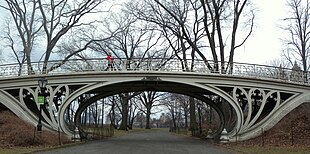
纽约市中央公园内卡尔弗特-沃克斯(Calvert Vaux)设计的一座桥由铸铁哥特式桁架支撑。
The arguments against modern construction materials began to collapse in the mid-19th century as great prefabricated structures such as the glass and iron Crystal Palace and the glazed courtyard of the Oxford University Museum of Natural History were erected, which appeared to embody Gothic principles.[o][125][126] Between 1863 and 1872 Viollet-le-Duc published his Entretiens sur l'architecture, a set of daring designs for buildings that combined iron and masonry.[127] Though these projects were never realised, they influenced several generations of designers and architects, notably Antoni Gaudí in Spain and, in England, Benjamin Bucknall, Viollet's foremost English follower and translator, whose masterpiece was Woodchester Mansion.[128] The flexibility and strength of cast-iron freed neo-Gothic designers to create new structural Gothic forms impossible in stone, as in Calvert Vaux's cast-iron Gothic bridge in Central Park, New York dating from the 1860. Vaux enlisted openwork forms derived from Gothic blind-arcading and window tracery to express the spring and support of the arching bridge, in flexing forms that presage Art Nouveau.[129]
19 世纪中期,随着玻璃和铁制的水晶宫以及牛津大学自然历史博物馆的玻璃庭院等大型预制建筑的建成,反对现代建筑材料的论调开始瓦解,这些建筑似乎体现了哥特式原则。 [o] [125] [126] 1863 年至 1872 年间,维奥莱特-勒杜克出版了《建筑论文集》(Entretiens sur l'architecture),这是一套大胆的铁与砖石结合的建筑设计。 [127] 虽然这些项目从未实现,但却影响了几代设计师和建筑师,特别是西班牙的安东尼-高迪和英国的本杰明-巴克纳尔,他是维奥莱特最重要的英国追随者和翻译,其代表作是伍德切斯特大厦。 [128] 铸铁的灵活性和强度使新哥特式设计师得以创造出石头无法实现的新哥特式结构形式,例如卡尔弗特-沃克斯(Calvert Vaux)于 1860 年在纽约中央公园建造的哥特式铸铁桥。沃克斯采用了哥特式盲弧线和窗花的镂空形式来表现拱桥的弹力和支撑力,其弯曲形式预示了新艺术主义。 [129]
Collegiate Gothic 学院派哥特式[edit]
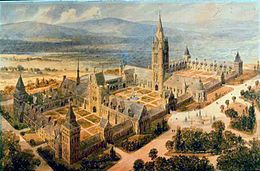
哈特福德三一学院:伯格斯修订的三四边形总体规划图
In the United States, Collegiate Gothic was a late and literal resurgence of the English Gothic Revival, adapted for American college and university campuses. The term "Collegiate Gothic" originated from American architect Alexander Jackson Davis's handwritten description of his own "English Collegiate Gothic Mansion" of 1853 for the Harrals of Bridgeport.[130][131] By the 1890s, the movement was known as "Collegiate Gothic".[132]
在美国,学院哥特式(Collegiate Gothic)是英国哥特式复兴的晚期和字面意义上的复兴,适用于美国的学院和大学校园。学院派哥特式 "一词源于美国建筑师亚历山大-杰克逊-戴维斯 1853 年为布里奇波特的哈拉尔家族建造的 "英国学院派哥特式大厦 "的手写描述。 [130] [131] 到 19 世纪 90 年代,这一运动被称为 "学院派哥特式"。 [132]
The firm of Cope & Stewardson was an early and important exponent, transforming the campuses of Bryn Mawr College,[133] Princeton University[134] and the University of Pennsylvania in the 1890s.[135] In 1872, Abner Jackson, the President of Trinity College, Connecticut, visited Britain, seeking models and an architect for a planned new campus for the college. William Burges was chosen and he drew up a four-quadrangled masterplan, in his Early French style. Lavish illustrations were produced by Axel Haig.[136] However, the estimated cost, at just under one million dollars, together with the sheer scale of the plans, thoroughly alarmed the College Trustees[137] and only one-sixth of the plan was executed, the present Long Walk, with Francis H. Kimball acting as local, supervising, architect, and Frederick Law Olmsted laying out the grounds.[136] Hitchcock considers the result, "perhaps the most satisfactory of all of [Burges's] works and the best example anywhere of Victorian Gothic collegiate architecture".[138]
科普与斯图尔德森公司是早期的重要倡导者,在 19 世纪 90 年代改造了布林莫尔学院、 [133] 普林斯顿大学 [134] 和宾夕法尼亚大学的校园。 [135] 1872 年,康涅狄格州三一学院院长艾伯纳-杰克逊访问英国,为学院规划的新校园寻找模型和建筑师。威廉-伯格斯(William Burges)被选中,他按照自己的早期法式风格绘制了一份四四方方的总体规划图。阿克塞尔-海格(Axel Haig)绘制了精美的插图。 [136] 然而,不到一百万美元的估算成本以及规划的庞大规模彻底惊动了学院董事会 [137] ,最终只实施了规划的六分之一,即现在的长廊,由弗朗西斯-H-金博尔(Francis H. Kimball)担任当地的监理建筑师,弗雷德里克-劳-奥姆斯特德(Frederick Law Olmsted)负责场地的布置。 [136] 希区柯克认为,这一成果 "也许是(伯格斯的)所有作品中最令人满意的,也是维多利亚哥特式学院建筑的最佳范例"。 [138]
The movement continued into the 20th century, with Cope & Stewardson's campus for Washington University in St. Louis (1900–1909),[139] Charles Donagh Maginnis's buildings at Boston College (1910s) (including Gasson Hall),[140] Ralph Adams Cram's design for the Princeton University Graduate College (1913),[141] and James Gamble Rogers' reconstruction of the campus of Yale University (1920s).[142] Charles Klauder's Gothic Revival skyscraper on the University of Pittsburgh's campus, the Cathedral of Learning (1926) exhibited Gothic stylings both inside and out, while using modern technologies to make the building taller.[143]
这一运动一直延续到 20 世纪,包括科普和斯图尔德森为圣路易斯华盛顿大学设计的校园(1900-1909 年)、查尔斯-多纳-马金尼斯为波士顿学院设计的建筑(1910 年代)(包括加森大厅)、拉尔夫-亚当斯-克拉姆为普林斯顿大学研究生院设计的建筑(1913 年)、詹姆斯-甘布尔-罗杰斯为耶鲁大学重建的校园(1920 年代)。3#查尔斯-克劳德(Charles Klauder)在匹兹堡大学校园内设计的哥特式复兴摩天大楼--学习大教堂(1926 年),从里到外都展现了哥特式风格,同时利用现代技术使建筑变得更高。 [143]
Vernacular adaptations and the revival in the Antipodes
本土化改编和南半球的复兴[edit]
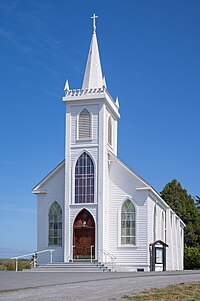
加利福尼亚州博德加的圣阿维拉教堂
Carpenter Gothic houses and small churches became common in North America and other places in the late 19th century.[144] These structures adapted Gothic elements such as pointed arches, steep gables, and towers to traditional American light-frame construction. The invention of the scroll saw and mass-produced wood moldings allowed a few of these structures to mimic the florid fenestration of the High Gothic. But, in most cases, Carpenter Gothic buildings were relatively unadorned, retaining only the basic elements of pointed-arch windows and steep gables. A well-known example of Carpenter Gothic is a house in Eldon, Iowa, that Grant Wood used for the background of his painting American Gothic.[145]
19 世纪晚期,木匠哥特式房屋和小型教堂在北美和其他地方变得十分普遍。这些建筑将尖拱门、陡峭的屋檐和塔楼等哥特式元素运用到传统的美国轻型框架结构中。卷轴锯和大量生产的木模的发明使其中一些建筑能够模仿高级哥特式的华丽花饰。但在大多数情况下,卡彭特哥特式建筑都相对朴素,只保留了尖拱窗和陡峭屋檐的基本元素。卡彭特哥特式建筑的一个著名例子是爱荷华州埃尔登的一栋房子,格兰特-伍德(Grant Wood)曾用这栋房子作为其油画《美国哥特式建筑》的背景。 [145]
New Zealand and Australia
新西兰和澳大利亚[edit]
Benjamin Mountfort, born in Britain, trained in Birmingham, and subsequently resident in Canterbury, New Zealand imported the Gothic Revival style to his adopted country and designed Gothic Revival churches in both wood and stone, notably in the city of Christchurch.[146] Frederick Thatcher designed wooden churches in the Gothic Revival style, for example Old St. Paul's, Wellington, contributing to what has been described as New Zealand's "one memorable contribution to world architecture".[147] St Mary of the Angels, Wellington by Frederick de Jersey Clere is in the French Gothic style, and was the first Gothic design church built in ferro-concrete.[148] The style also found favour in the southern New Zealand city of Dunedin, where the wealth brought in by the Otago Gold Rush of the 1860s allowed for substantial stone edifices to be constructed, using hard, dark breccia stone and a local white limestone, Oamaru stone, among them Maxwell Bury's University of Otago Registry Building[149] and the Dunedin Law Courts by John Campbell.[150]
本杰明-蒙特福特(Benjamin Mountfort)出生于英国,在伯明翰接受过培训,随后定居于新西兰坎特伯雷,他将哥特复兴风格引入了自己的祖国,并设计了木质和石质的哥特复兴风格教堂,尤其是在基督城。 [146] 弗雷德里克-撒切尔设计了哥特复兴风格的木制教堂,如惠灵顿的老圣保罗教堂,被誉为新西兰 "对世界建筑的一个令人难忘的贡献"。 [147] 弗雷德里克-德-泽西-克莱尔(Frederick de Jersey Clere)设计的惠灵顿天使圣玛丽教堂(St Mary of the Angels)采用了法国哥特式风格,是第一座采用铁混凝土建造的哥特式设计教堂。 [148] 这种风格在新西兰南部城市但尼丁也很受欢迎,19 世纪 60 年代奥塔哥淘金热带来的财富使得当地可以使用坚硬的深色角砾岩石材和当地的白色石灰石--奥马鲁石材建造大型石材建筑,其中包括麦克斯韦-布里设计的奥塔哥大学注册大楼 [149] 和约翰-坎贝尔设计的但尼丁法院。 [150]
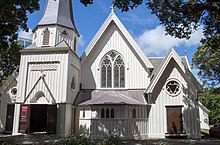
新西兰惠灵顿老圣保罗教堂
Australia, in particular in Melbourne and Sydney, saw the construction of large numbers of Gothic Revival buildings. William Wardell (1823–1899) was among the country's most prolific architects; born and trained in England, after emigrating his most notable Australian designs include St Patrick's Cathedral, Melbourne and St John's College and St Mary's Cathedral in Sydney. In common with many other 19th century architects, Wardell could deploy different styles at the command of his clients; Government House, Melbourne is Italianate.[151] His banking house for the English, Scottish and Australian Bank in Melbourne has been described as "the Australian masterpiece of neo-Gothic".[152] This claim has also been made for Edmund Blacket's MacLaurin Hall at the University of Sydney,[153] which sits in the quadrangle complex described as "arguably the most important group of Gothic and Tudor Revival style architecture in Australia".[154]
澳大利亚,尤其是墨尔本和悉尼,建造了大量哥特复兴式建筑。威廉-沃德尔(William Wardell,1823-1899 年)是澳大利亚最多产的建筑师之一;他在英国出生并接受训练,移民澳大利亚后,他最著名的设计包括墨尔本的圣帕特里克大教堂、悉尼的圣约翰学院和圣玛丽大教堂。与许多其他 19 世纪的建筑师一样,沃德尔可以根据客户的要求采用不同的风格;墨尔本的政府大楼就是意大利风格。 [151] 他在墨尔本为英格兰、苏格兰和澳大利亚银行建造的银行大楼被誉为 "澳大利亚新哥特式建筑的杰作"。 [152] 埃德蒙-布莱克特(Edmund Blacket)在悉尼大学设计的麦克劳林大厅(MacLaurin Hall)也被称为 "澳大利亚最重要的哥特式和都铎复兴风格建筑群"。 [154]
Global Gothic 全球哥特式[edit]
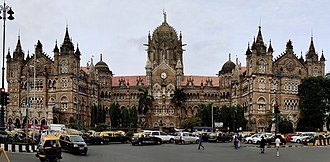
印度孟买的 Chhatrapati Shivaji Terminus。它融合了罗马式、哥特式和印度元素。
Henry-Russell Hitchcock, the architectural historian, noted the spread of the Gothic Revival in the 19th and early 20th centuries, "wherever English culture extended – as far as the West Coast of the United States and to the remotest Antipodes".[155] The British Empire, almost at its geographic peak at the height of the Gothic Revival, assisted or compelled this spread. The English-speaking dominions, Canada, Australia particularly the state of Victoria and New Zealand generally adopted British styles in toto (see above); other parts of the empire saw regional adaptations. India saw the construction of many such buildings, in styles termed Indo-Saracenic or Hindu-Gothic.[p][157] Notable examples include Chhatrapati Shivaji Terminus (formerly Victoria Terminus)[158] and the Taj Mahal Palace Hotel, both in Mumbai.[159] At the hill station of Shimla, the summer capital of British India, an attempt was made to recreate the Home counties in the foothills of the Himalayas. Although Gothic Revival was the predominant architectural style, alternatives were also deployed; Rashtrapati Niwas, the former Viceregal Lodge, has been variously described as Scottish Baronial Revival,[160] Tudor Revival[161] and Jacobethan.[q][163]
建筑历史学家亨利-拉塞尔-希区柯克(Henry-Russell Hitchcock)指出,哥特式复兴在 19 世纪和 20 世纪初的传播,"无论英国文化延伸到哪里--远至美国西海岸,近至遥远的南半球"。大英帝国在哥特式复兴时期几乎达到了地理上的顶峰,它帮助或迫使了这种传播。英语领地、加拿大、澳大利亚(尤其是维多利亚州)和新西兰一般都全面采用了英国风格(见上文);帝国的其他地区则进行了地区性调整。印度建造了许多此类建筑,其风格被称为印度-萨拉凯尼式(Indo-Saracenic)或印度-哥特式(Hindu-Gothic)。 [p] [157] 著名的例子包括位于孟买的 Chhatrapati Shivaji Terminus(前身为 Victoria Terminus) [158] 和泰姬陵皇宫酒店。 [159] 在英属印度的夏都西姆拉山站,人们试图在喜马拉雅山麓重现本土郡县的风貌。虽然哥特式复兴是主要的建筑风格,但也有其他的建筑风格;Rashtrapati Niwas(前总督府)被描述为苏格兰男爵式复兴、 [160] 都铎式复兴 [161] 和雅各贝特式。 [q] [163]
Other examples in the east include the late 19th century Church of the Saviour, Beijing, constructed on the orders of the Guangxu Emperor and designed by the Catholic missionary and architect Alphonse Favier;[164] and the Wat Niwet Thammaprawat in the Bang Pa-In Royal Palace in Bangkok, by the Italian Joachim Grassi.[165] In Indonesia, (the former colony of the Dutch East Indies), the Jakarta Cathedral was begun in 1891 and completed in 1901 by Dutch architect Antonius Dijkmans;[166] while further north in the islands of the Philippines, the San Sebastian Church, designed by architects Genaro Palacios and Gustave Eiffel, was consecrated in 1891 in the still Spanish colony.[167] Church building in South Africa was extensive, with little or no effort to adopt vernacular forms. Robert Gray, the first bishop of Cape Town, wrote; "I am sure we do not overestimate the importance of real Churches built after the fashion of our English churches". He oversaw the construction of some fifty such buildings between 1848 and his death in 1872.[r][169] South America saw a later flourishing of the Revival, particularly in church architecture,[170] for example the Metropolitan Cathedral of São Paulo in Brazil by the German Maximilian Emil Hehl,[171] and the Cathedral of La Plata in Argentina.[172]
东方的其他例子包括 19 世纪晚期的北京救世主教堂,该教堂由天主教传教士兼建筑师阿尔方斯-法维耶(Alphonse Favier)设计,由光绪皇帝下令建造; [164] 以及位于曼谷 Bang Pa-In 皇家宫殿内的 Wat Niwet Thammaprawat,由意大利人约阿希姆-格拉西(Joachim Grassi)设计。 [165] 在印度尼西亚(前荷属东印度群岛殖民地),雅加达大教堂由荷兰建筑师安东尼斯-迪克曼斯(Antonius Dijkmans)于 1891 年动工,1901 年完工; [166] 而在更北边的菲律宾群岛,由建筑师热纳罗-帕拉西奥斯(Genaro Palacios)和古斯塔夫-埃菲尔(Gustave Eiffel)设计的圣塞巴斯蒂安教堂于 1891 年在这个仍是西班牙殖民地举行了祝圣仪式。 [167] 南非的教堂建设规模很大,但几乎没有采用本土形式。开普敦的第一任主教罗伯特-格雷写道:"我相信,我们不会高估按照英国教堂的样式建造的真正教堂的重要性。从 1848 年到他 1872 年去世,他监督建造了约 50 座这样的建筑。 [r] [169] 南美洲的复兴运动后来得到了蓬勃发展,尤其是在教堂建筑方面, [170] 例如德国人马克西米利安-埃米尔-赫尔(Maximilian Emil Hehl)设计的巴西圣保罗大都会大教堂, [171] 以及阿根廷的拉普拉塔大教堂。 [172]
20th and 21st centuries 20 世纪和 21 世纪[edit]
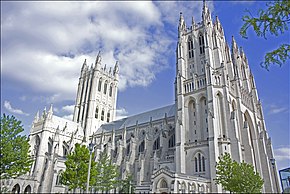
华盛顿国家大教堂于 1907 年开始建造,1990 年竣工。
The Gothic style dictated the use of structural members in compression, leading to tall, buttressed buildings with interior columns of load-bearing masonry and tall, narrow windows. But, by the start of the 20th century, technological developments such as the steel frame, the incandescent light bulb and the elevator made this approach obsolete. Steel framing supplanted the non-ornamental functions of rib vaults and flying buttresses, providing wider open interiors with fewer columns interrupting the view.
哥特式建筑风格决定了结构构件的压缩使用,从而导致了高大、有支撑、内部柱子由承重砖石砌成、窗户又高又窄的建筑。但是,到了 20 世纪初,钢框架、白炽灯泡和电梯等技术的发展使这种方法过时了。钢框架取代了肋拱顶和飞扶壁的非基本功能,提供了更宽阔开放的室内空间,减少了干扰视线的柱子。
Some architects persisted in using Neo-Gothic tracery as applied ornamentation to an iron skeleton underneath, for example in Cass Gilbert's 1913 Woolworth Building[173] skyscraper in New York and Raymond Hood's 1922 Tribune Tower in Chicago.[174] The Tower Life Building in San Antonio, completed in 1929, is noted for the arrays of decorative gargoyles on its upper floors.[175] But, over the first half of the century, Neo-Gothic was supplanted by Modernism, although some modernist architects saw the Gothic tradition of architectural form entirely in terms of the "honest expression" of the technology of the day, and saw themselves as heirs to that tradition, with their use of rectangular frames and exposed iron girders.
一些建筑师坚持使用新哥特式桁架作为铁骨架下的应用装饰,例如卡斯-吉尔伯特(Cass Gilbert)1913 年设计的纽约伍尔沃斯大厦(Woolworth Building) [173] 和雷蒙德-胡德(Raymond Hood)1922 年设计的芝加哥论坛报大厦(Tribune Tower) [174] 。 [174] 1929 年建成的圣安东尼奥塔式人寿大厦以其上层的装饰性石像鬼阵列而闻名。 [175] 但是,在本世纪上半叶,新哥特式建筑被现代主义所取代,尽管一些现代主义建筑师认为哥特式建筑形式传统完全是当时技术的 "诚实表达",并将自己视为该传统的继承者,他们使用矩形框架和外露的铁梁。

利物浦大教堂,从 1903 年至 1978 年期间一直在修建中
In spite of this, the Gothic Revival continued to exert its influence, simply because many of its more massive projects were still being built well into the second half of the 20th century, such as Giles Gilbert Scott's Liverpool Cathedral[176] and the Washington National Cathedral (1907–1990).[177] Ralph Adams Cram became a leading force in American Gothic, with his most ambitious project the Cathedral of St. John the Divine in New York (claimed to be the largest cathedral in the world), as well as Collegiate Gothic buildings at Princeton University.[178] Cram said "the style hewn out and perfected by our ancestors [has] become ours by uncontested inheritance".[179]
尽管如此,哥特式复兴仍在继续发挥其影响力,原因很简单,因为直到 20 世纪下半叶,哥特式复兴中的许多大型项目仍在建造之中,如吉尔斯-吉尔伯特-斯科特的利物浦大教堂 [176] 和华盛顿国家大教堂(1907-1990 年)。拉尔夫-亚当斯-克拉姆(Ralph Adams Cram)成为美国哥特式建筑的领军人物,他最雄心勃勃的作品是纽约圣约翰大教堂(据称是世界上最大的大教堂),以及普林斯顿大学的学院派哥特式建筑。 [178] 克拉姆说,"我们的祖先凿出并完善的风格[已]毫无争议地继承下来,成为我们的风格"。 [179]
Though the number of new Gothic Revival buildings declined sharply after the 1930s, they continue to be built. St Edmundsbury Cathedral, the cathedral of Bury St Edmunds in Suffolk, was expanded and reconstructed in a neo-Gothic style between the late 1950s and 2005, and a commanding stone central tower was added.[180] A new church in the Gothic style is planned for St. John Vianney Parish in Fishers, Indiana.[181][182] The Whittle Building at Peterhouse, University of Cambridge, opened in 2016, matches the neo-Gothic style of the rest of the courtyard in which it is situated.[183]
尽管 20 世纪 30 年代后哥特复兴风格的新建筑数量急剧下降,但这些建筑仍在继续建造。萨福克郡伯里圣埃德蒙兹伯里大教堂(St Edmundsbury Cathedral)在 20 世纪 50 年代末至 2005 年期间进行了新哥特式风格的扩建和重建,并增建了一座雄伟的石制中央塔楼。 [180] 印第安纳州菲舍斯的圣约翰-维亚尼教区计划修建一座哥特式风格的新教堂。 [181] [182] 剑桥大学彼得豪斯学院的惠特尔大楼于 2016 年启用,与所在庭院的其他部分的新哥特式风格相匹配。 [183]
Appreciation 鉴赏[edit]
By 1872, the Gothic Revival was mature enough in the United Kingdom that Charles Locke Eastlake, an influential professor of design, could produce A History of the Gothic Revival.[184] Kenneth Clark's, The Gothic Revival. An Essay, followed in 1928, in which he described the Revival as "the most widespread and influential artistic movement which England has ever produced."[185] The architect and writer Harry Stuart Goodhart-Rendel covered the subject of the Revival in an appreciative way in his Slade Lectures in 1934.[s][187] But the conventional early 20th century view of the architecture of the Gothic Revival was strongly dismissive, critics writing of "the nineteenth century architectural tragedy",[188] ridiculing "the uncompromising ugliness"[189] of the era's buildings and attacking the "sadistic hatred of beauty" of its architects.[190][t] The 1950s saw further signs of a recovery in the reputation of Revival architecture. John Steegman's study, Consort of Taste (re-issued in 1970 as Victorian Taste, with a foreword by Nikolaus Pevsner), was published in 1950 and began a slow turn in the tide of opinion "towards a more serious and sympathetic assessment."[192] In 1958, Henry-Russell Hitchcock published his Architecture: Nineteenth and Twentieth Centuries, as part of the Pelican History of Art series edited by Nikolaus Pevsner. Hitchcock devoted substantial chapters to the Gothic Revival, noting that, while "there is no more typical nineteenth-century product than a Victorian Gothic church",[193] the success of the Victorian Gothic saw its practitioners design mansions,[84] castles,[194] colleges,[195] and parliaments.[193] The same year saw the foundation of the Victorian Society in England and, in 1963, the publication of Victorian Architecture, an influential collection of essays edited by Peter Ferriday.[196] By 2008, the fiftieth anniversary of the founding of the Victorian Society, the architecture of the Gothic Revival was more fully appreciated with some of its leading architects receiving scholarly attention and some of its best buildings, such as George Gilbert Scott's St Pancras Station Hotel, being magnificently restored.[197] The Society's 50th anniversary publication, Saving A Century, surveyed a half-century of losses and successes, reflected on the changing perceptions toward Victorian architecture and concluded with a chapter entitled "The Victorians Victorious".[198]
到 1872 年,哥特式复兴在英国已经足够成熟,以至于查尔斯-洛克-伊斯特莱克(Charles Locke Eastlake)这位颇具影响力的设计学教授可以编写《哥特式复兴史》。肯尼斯-克拉克(Kenneth Clark)的《哥特式复兴》。在这本书中,他将复兴运动描述为 "英国有史以来最广泛、最具影响力的艺术运动"。 [185] 建筑师兼作家哈里-斯图尔特-古德哈特-伦德尔(Harry Stuart Goodhart-Rendel)在 1934 年的《斯莱德讲座》(Slade Lectures)中以赞赏的方式论述了复兴运动的主题。 [s] [187] 但 20 世纪初对哥特式复兴建筑的传统看法是强烈的轻蔑,评论家们写道 "19 世纪的建筑悲剧", [188] 讥讽 "毫不妥协的丑陋", [189] 称其为 "建筑史上的悲剧"。 [189] 并抨击其建筑师 "对美的痛恨"。 [190] [t] 20 世纪 50 年代,复兴派建筑的声誉有了进一步恢复的迹象。约翰-斯蒂格曼(John Steegman)的研究报告《Consort of Taste》(1970 年作为《Victorian Taste》再版,由尼古拉斯-佩夫斯纳(Nikolaus Pevsner)撰写前言)于 1950 年出版,开始了舆论的缓慢转向,"转向更加严肃和同情的评价"。 [192] 1958 年,亨利-拉塞尔-希区柯克出版了他的《建筑学》:作为尼古拉斯-佩夫斯纳(Nikolaus Pevsner)编辑的鹈鹕艺术史系列丛书的一部分。希区柯克用大量篇幅介绍了哥特式复兴,他指出,虽然 "没有比维多利亚哥特式教堂更典型的十九世纪产品了", [193] 但维多利亚哥特式的成功使其从业者设计出了豪宅、 [84] 城堡、 [194] 学院、 [195] 和议会。 [193] 同年,英国维多利亚学会成立,1963 年,由彼得-费里戴编辑的具有影响力的论文集《维多利亚建筑》出版。 [196] 2008 年,维多利亚协会成立 50 周年之际,哥特复兴时期的建筑得到了更充分的重视,一些著名的建筑师受到了学术界的关注,一些最好的建筑,如乔治-吉尔伯特-斯科特(George Gilbert Scott)的圣潘克拉斯车站酒店,也得到了华丽的修复。该协会的 50 周年纪念出版物《拯救一个世纪》回顾了半个世纪以来的损失和成功,反思了人们对维多利亚时期建筑不断变化的看法,并以题为 "维多利亚时代的胜利者 "的章节作为结尾。 [198]
Gallery 画廊[edit]
Europe 欧洲[edit]
-
Hungarian Parliament Building, Budapest, Hungary: 1885–1904
-
Manchester Town Hall, England: 1868–1877
-
New Town Hall, Munich, Germany: 1867–1874
-
Co-cathedral, Osijek, Croatia: 1898
-
St Pancras railway station, London, England: 1863–1868
-
Rossio Station, Lisbon, Portugal: 1886–1887
-
Schwerin Castle, Germany: 1845–1857
-
Sturdza Palace, Iași County, Romania: 1880–1904
-
Vienna City Hall, Austria: 1872–1883
-
De Haar Castle, Utrecht, The Netherlands: 1892–1907
North America[edit]
-
Cathedral of Santa Ana, El Salvador: 1906–1913
-
Rockefeller College, Princeton, USA: 1877
-
Templo Expiatorio del Santísimo Sacramento, Guadalajara, Jalisco, Mexico: 1897–1972
-
St. Patrick's Cathedral, New York, USA: 1858–1879
South America[edit]
-
Basilica of Our Lady of Luján, Buenos Aires Province, Argentina: 1890–1935
-
Basilica del Salvador, Santiago, Chile: 1913–1954
-
Capilla Cristo Pobre, Jauja, Peru: 1884–1925
-
Cathedral of São Pedro de Alcântara, Petrópolis, Brazil: 1884–1925
-
Castle of Fiscal Island, Rio de Janeiro, Brazil: 1881–1889
-
Church of Our Lady of Lourdes, Canela, Brazil: 1953–1987
Australia and New Zealand[edit]
-
University of Sydney Quadrangle, Sydney, Australia: 1854-1862
-
St Patrick's Cathedral, Melbourne, Australia: 1858-1939
-
ChristChurch Cathedral, New Zealand: 1864–1904
-
Auckland High Court, New Zealand: 1865–1867
-
St Mary's Cathedral, Sydney, Australia: 1868–1928
-
St Paul's Cathedral, Melbourne, Australia: 1880–1891
-
Otago Boys' High School, New Zealand: 1882–1885
-
Sacred Heart Cathedral, Bendigo, Australia: 1895–1901
Asia[edit]
-
Church of the Saviour, Baku, Azerbaijan: 1896–1899
-
Basilica of the Sacred Heart of Jesus, Pondicherry, India: 1902–1907
-
Jakarta Cathedral, Indonesia: 1891–1901
-
Basílica Menor de San Sebastián, Manila, Philippines: 1888–1891
-
Sacred Heart Cathedral, Guangzhou, China: 1861–1888
-
Government College University, Lahore, Pakistan: 1877
Decorative arts[edit]
-
Cup and saucer, produced by the Sèvres porcelain factory and decorated by Pierre Huard, 1827, porcelain, Cleveland Museum of Art, Cleveland, Ohio, US
-
Clock, unknown French maker, c. 1835–1840, gilt and patinated bronze, Museum of Decorative Arts, Paris
-
Pair of vases, by Alexandre-Évariste Fragonard and the Sèvres porcelain factory, manufactured in 1832, decorated in 1844, hard-paste porcelain, Metropolitan Museum of Art, New York City
-
Desk, by Kimbel and Cabus, c. 1877, oak, nickel-plated brass and iron hardware, Metropolitan Museum of Art
Footnotes[edit]
- ^ The driver of the redecoration at University College was Sir Roger Newdigate, who also undertook the "Gothicisation" of his Warwickshire country house, Arbury Hall, over the course of 50 years in the later half of the 18th century.[16]
- ^ This was Walpole's appraisal of the sham castle at Hagley Park, Worcestershire designed by his friend, Sanderson Miller.[24]
- ^ Tours of the house, conducted by Walpole's housekeeper, Margaret Young, proved hugely popular. Walpole wrote to a friend; "I am so tormented by droves of people coming to see my house, and Margaret gets such sums of money by showing it, that I have a mind to marry her".[25]
- ^ Alfred's Hall, built by Lord Bathurst on his Cirencester Park estate between 1721 and 1732 in homage to Alfred the Great,[28] is perhaps the earliest Gothic Revival structure in England.[29]
- ^ The little-researched Clearwell Castle in Gloucestershire, by Roger Morris who also undertook work at Inveraray, has been described as "the earliest Gothick Revival castle in England".[31]
- ^ Thomas Rickman trained as an accountant and his posthumous famed rested on his antiquarian researches, rather than his considerable corpus of buildings, which were disparaged as the creations of a "self-taught" architect. It was only towards the end of his life, and after, that the position of architect was recognised as a profession, with the establishment of the Institute of British Architects in 1834 and the Architectural Association in 1847.[39]
- ^ Sir Walter Scott's novels popularised the Medieval period and their influence went well beyond architecture. The historian Robert Bartlett notes that, at one point in the mid-19th century, four different stage adaptations of Ivanhoe were running simultaneously in London theatres, and nine separate operas were based on the work.[46]
- ^ In Montreal, Quebec, Canada, the earlier neo-Gothic Basilica of Notre Dame (1824) belongs to the Gothic Revival exported from Great Britain and the United States. Its architect, James O'Donnell, was an Irish immigrant with no known connections to France.[68]
- ^ The choice of the canonized wife of King Clovis, the first Christian king of a unified France, held significance for the Bourbons.[69]
- ^ Pugin subsequently recanted, writing in the second of his two lectures, The True Principles of Pointed or Christian Architecture; "A man who remains any length of time in a modern Gothic room, and escapes without being wounded by some of its minutiae, may consider himself extremely fortunate. There are often as many pinnacles and gables about a pier glass frame as are to be found in a church. I have perpetrated many of these enormities in the furniture I designed some years ago for Windsor Castle... Collectively they appeared a complete burlesque of pointed design".[98]
- ^ Pugin recorded his delight at the destruction of what he considered the wholly inadequate earlier restorations of James Wyatt and John Soane. "You have doubtless seen the accounts of the late great conflagration at Westminster. There is nothing much to regret...a vast amount of Soane's mixtures and Wyatt's heresies have been consigned to oblivion. Oh it was a glorious sight to see his composition mullions and cement pinnacles flying and cracking."[103]
- ^ Ruskin also had an abhorrence of the contemporary "restorer" of Gothic buildings. Writing in the Preface to the first edition of his The Seven Lamps of Architecture, he remarked; "[My] whole time has been lately occupied in taking drawings from the one side of buildings, of which masons were knocking down the other".[106]
- ^ The rumour that Scott repurposed his Foreign Office design for the Midland Grand Hotel is unfounded.[109]
- ^ In the Preface to his Dictionary of French Architecture from 11th to 16th Century (1854–1868) (Dictionnaire raisonné de l'architecture française du XIe au XVIe siècle), le-Duc wrote of the ignorance of Gothic architecture prevalent at the start of the 19th century: "as for [buildings] which had been constructed between the end of the Roman empire and the fifteenth century, they were scarcely spoken of except to be cited as the products of ignorance or barbarousness".[119]
- ^ Ruskin was unimpressed by Joseph Paxton's Crystal Palace, describing it as nothing but "a greenhouse larger than ever greenhouse was built before".[124]
- ^ William Burges’s unexecuted plans for the Sir J. J. School of Art, the “most marvellous design that he ever made”, were described as “compelling rigid thirteenth century Gothic to fulfil the requirements of the torrid zone”.[156]
- ^ Thomas R. Metcalf, in his study An Imperial Vision: Indian Architecture and the British Raj, records a debate at the Royal Society of Arts in London in 1873 between proponents of the European and indigenous approaches. While T. Roger Smith contended that, "as our administration exhibits European justice, order, law and honour, so our buildings ought to hold up a high standard of European art", William Emerson argued that "it is impossible for the architecture of the west to be suitable for the natives of the east".[162]
- ^ An unusual feature of the church building programme overseen by Bishop Gray was that the majority of the churches were designed by his wife, Sophy, a considerable rarity at a time when women were almost entirely excluded from the professions.[168]
- ^ In his speech in 1976, on receiving the RIBA Gold Medal, Sir John Summerson recalled Rendel's contribution; "It was well known that Victorian architecture was bad or screamingly funny, or both. Rendel begged to differ, but what really stunned his audience was that he knew, and knew in great detail, what he was talking about".[186]
- ^ Kenneth Clark, despite his sympathetic approach, recalled that during his Oxford years it was generally believed not only that Keble College was "the ugliest building in the world" but that its architect was John Ruskin, author of The Stones of Venice. The college was built to the designs of the architect William Butterfield.[191]
See also[edit]
Sub-varieties of the Gothic Revival style[edit]
Locale[edit]
References[edit]
- ^ Curl 1990, pp. 14–15.
- ^ "Pugin and the Gothic Revival". Archived from the original on 6 October 2007. Retrieved 12 July 2010.
- ^ Jump up to: a b Cooke 1987, p. 383.
- ^ "The Castle of Otranto: Collection items". British Library. Retrieved 20 August 2023.
- ^ Robson Scott 1965, p. unknown.
- ^ Furneaux Jordan 1979, p. 127.
- ^ Furneaux Jordan 1979, p. 163.
- ^ Furneaux Jordan 1979, p. 165.
- ^ Hunter, Bob (18 September 2014). "Londonderry Cathedral". Wars & Conflict: The Plantation of Ulster. BBC.
- ^ Sherwood & Pevsner 2002, pp. 110–111.
- ^ "Northern Ireland – Historic Building Details HB17/15/022 A, Dromore Cathedral". Department of Communities - NI Government. Retrieved 17 August 2023.
- ^ Historic England. "Lambeth Palace (Grade I) (1116399)". National Heritage List for England. Retrieved 17 August 2023.
- ^ Historic England. "Church of St Nicholas, Alcester (Grade I) (1200612)". National Heritage List for England. Retrieved 17 August 2023.
- ^ Macaulay 1975, p. 31.
- ^ "Vézelay et le gothique comme acte constructif" (in French). Universalis.fr. Retrieved 17 August 2023.
- ^ Historic England. "Arbury Hall (Grade !) (1185222)". National Heritage List for England. Retrieved 20 August 2023.
- ^ Cox 2012, p. 117.
- ^ "Église Saint-Eustache". Paris tourist office. Retrieved 6 May 2020.
- ^ "Guarino Guarini : Italian architect, priest, mathematician, and theologian". Encyclopedia Britannica. n.d. Retrieved 7 September 2018.
- ^ "Pilgrimage Church of St. John of Nepomuk at Zelená Hora". UNESCO World Heritage Centre. United Nations Educational, Scientific, and Cultural Organization. Retrieved 24 February 2023.
- ^ Nagy, Gergely Domonkos (2013). "Gothicized buildings and the role of symbols in Baroque architecture". Periodica Polytechnica Architecture. 44 (2): 69–76. doi:10.3311/PPar.7396. ISSN 1789-3437.
- ^ Aldrich 2005, p. 140.
- ^ Chalcraft & Viscardi 2007, p. 7.
- ^ Jump up to: a b Brooks & Pevsner 2007, p. 339.
- ^ Chalcraft & Viscardi 2007, p. 20.
- ^ Historic England. "Strawberry Hill (St Mary's Training College) (Grade I) (1261987)". National Heritage List for England. Retrieved 6 May 2020.
- ^ Historic England. "Lacock Abbey with Stable Yard (Grade I) (1283853)". National Heritage List for England. Retrieved 6 May 2020.
- ^ Historic England. "Alfreds Hall, Cirencester Park (Grade II*) (1298719)". National Heritage List for England. Retrieved 2 May 2020.
- ^ Charlesworth 2002a, p. 14.
- ^ Aldrich 2005, pp. 82–83.
- ^ Verey & Brooks 2002, pp. 310–311.
- ^ Gifford 1989, p. 161.
- ^ Cruft, Dunbar & Fawcett 2006, p. 529.
- ^ Cruft, Dunbar & Fawcett 2006, p. 744.
- ^ McWilliam 1978, pp. 428–431.
- ^ Whyte & Whyte 1991, p. 100.
- ^ "Batty Langley, gardener and prolific writer". www.twickenham-museum.org.uk. Twickenham Museum. Retrieved 6 May 2020.
- ^ Macaulay 1975, p. 174.
- ^ Aldrich 2019, p. 25.
- ^ Rickman 1848, p. 47.
- ^ Jump up to: a b Shannon Kyles. "Gothic Revival (1750–1900)". Ontario Architecture. Retrieved 6 May 2020.
- ^ "Gothic Revival". Encyclopædia Britannica Online. Retrieved 8 October 2013.
- ^ Lindfield 2016, p. 78.
- ^ "Style Guide: Gothic Revival". London, United Kingdom: Victoria and Albert Museum. Retrieved 6 May 2020.
- ^ "Thomas Chippendale". www.vam.ac.uk. Victoria and Albert Museum. 26 November 2012.
- ^ Bartlett 2001, p. 14.
- ^ Lindfield 2016, p. 224.
- ^ Anstruther 1963, preface.
- ^ Graur 1970, p. 233.
- ^ Chadenet 2001, pp. 116–117, 138.
- ^ Beard 1985, p. 72.
- ^ Pevsner 1951, foreword.
- ^ "Victoria: Gothic Crown". Baldwins. 19 March 2019.
- ^ "Queen Victoria: The Gothic Crown 1847". www.royalmint.com. The Royal Mint. Archived from the original on 24 June 2020. Retrieved 6 May 2020.
- ^ Bartlett 2001, p. 15.
- ^ "History of the Chapel Royal at Dreux". Chapelle Royale a Dreux Official Site. Retrieved 29 May 2020.
- ^ Gothein, Marie-Luise. "History of Garden Art – Jardin Anglo-Chinois". www.gardenvisit.com. The Landscape Guide. Retrieved 29 May 2020.
- ^ "Collections of the Musée de Normandie". mondes-normands.caen.fr. Normandy Museum. Retrieved 6 May 2020.
- ^ Lowenthal 2015, p. 416.
- ^ Barnes, Julian (7 July 2007). "An inspector calls". The Guardian.
- ^ Murphy, Kevin. "Memory and Modernity: Viollet-le-Duc at Vézelay". www.psupress.org. Penn State University Press. Retrieved 6 May 2020.
- ^ Jump up to: a b Midant 2002, p. 54.
- ^ Midant 2002, p. 19.
- ^ Jump up to: a b c Midant 2002, p. 96.
- ^ "Historique du Château -Anglais-".
- ^ "Mont-Saint-Michel and its Bay". UNESCO World Heritage Centre. Retrieved 6 May 2020.
- ^ Midant 2002, p. 108.
- ^ Toker 1991, pp. xviii–xix.
- ^ Menin 1775, p. 5.
- ^ "Western architecture – From the 19th to the early 20th century". Encyclopedia Britannica. n.d. Retrieved 6 May 2020.
- ^ Brichta 2014, p. ?.
- ^ Germann 1972, p. 152.
- ^ "Cologne Cathedral: History, Artworks, & Facts". Encyclopedia Britannica. Retrieved 6 May 2020.
- ^ "About St. Peter's Cathedral". domplatz-5.de. Infozentrum Domplatz. Archived from the original on 15 July 2020. Retrieved 6 May 2020.
- ^ "Ulm Minster (Ulm, 1890)". Structurae. Retrieved 6 May 2020.
- ^ Forrest, F. G. "St. Vitus Cathedral". www.fg.cz. Prague Castle. Retrieved 6 May 2020.
- ^ "Sint-Petrus-en-Pauluskerk" (in Dutch). City of Ostend. Retrieved 24 July 2011.
- ^ "Stadhuis" (in Dutch). City of Mechelen. Archived from the original on 18 July 2011. Retrieved 18 July 2011.
- ^ "Stadhuis met voormalige Lakenhal (ID: 3717)". De Inventaris van het Bouwkundig Erfgoed (in Dutch). Vlaams Instituut voor het Onroerend Erfgoed (VIOE). Retrieved 24 July 2011.
- ^ "Florence". Il Grande Museo del Duomo. Retrieved 6 May 2020.
- ^ Tuleshkov 2007, p. ?.
- ^ Stamp 1995, pp. 108–110.
- ^ Jackson 2011, p. 152.
- ^ Jump up to: a b c Hitchcock 1968, p. 94.
- ^ Hull 2006, p. 154.
- ^ Glendenning, MacInnes & MacKechnie 2002, pp. 276–285.
- ^ Jump up to: a b Buggeln 2003, p. 115.
- ^ Jarvis 1814.
- ^ Hobart 1816, p. 5.
- ^ Stanton 1997, p. 3.
- ^ "The creation of the Basilica – La Basilique Notre-Dame". www.basiliquenotredame.ca. Notre-Dame. Retrieved 6 May 2020.
- ^ "Parliament Buildings, Ottawa, Ontario, Canada". Encyclopedia Britannica. Retrieved 6 May 2020.
- ^ "Victoria Memorial Museum". www.historicplaces.ca. Register of Canada's Historic Places. Retrieved 6 May 2020.
- ^ "Royal Canadian Mint Historical Plaque". www.ontarioplaques.com. Ontario's Historic Plaques. Retrieved 6 May 2020.
- ^ "Connaught Building National Historic Site of Canada". www.pc.gc.ca. Parks Canada. Retrieved 6 May 2020.
- ^ Fulton 2005.
- ^ Aldrich & Atterbury 1995, p. 372.
- ^ Charlesworth 2002c, p. 199.
- ^ Hill 2007, pp. 74–75.
- ^ "Augustus Welby Northmore Pugin (1812–52)". The Victorian Web. Retrieved 3 October 2008.
- ^ Hill 2007, pp. 52–53.
- ^ Charlesworth 2002c, pp. 168–171.
- ^ Atterbury & Wainwright 1994, p. 219.
- ^ Hill 2007, p. 317.
- ^ Atterbury & Wainwright 1994, p. 221.
- ^ Ruskin 1989, p. ix.
- ^ Charlesworth 2002c, p. 343.
- ^ Dixon & Muthesius 1993, p. 160.
- ^ Cherry & Pevsner 2002, p. 362.
- ^ Stamp 2015, p. 152.
- ^ Clark 1983, pp. 155–174.
- ^ Port 2006, p. 327.
- ^ Germann 1972, p. 9.
- ^ Eastlake 2012, p. 141.
- ^ "St Luke's Church – A Brief History". St Luke's Parochial Church Council. Retrieved 2 November 2012.
- ^ "West Norwood Cemetery". The Courtauld Institute of Art. Retrieved 6 May 2020.
- ^ Stamp 1997, p. 1.
- ^ Historic England (1 October 1987). "Abney Park Cemetery, Hackney (1000789)". National Heritage List for England. Retrieved 11 May 2018.
- ^ Charlesworth 2002c, p. 611.
- ^ Pevsner 1969, p. 18.
- ^ Midant 2002, p. 35.
- ^ Midant 2002, p. 154.
- ^ Pevsner 1969, p. 17.
- ^ Pevsner 1969, p. 37.
- ^ "The Crystal Palace of Hyde Park". University of Oregon. Archived from the original on 12 March 2012. Retrieved 4 April 2008.
- ^ "The Museum's architecture". www.oumnh.ox.ac.uk. Oxford University Museum of Natural History. Retrieved 6 May 2020.
- ^ Pevsner 1969, p. 34.
- ^ Historic England. "The Mansion, Woodchester (1340703)". National Heritage List for England. Retrieved 11 May 2018.
- ^ "Gothic Bridge (94th street)". www.centralpark.com. Central Park. Retrieved 6 May 2020.
- ^ Truettner, Julia M. (31 December 2002). Aspirations for Excellence: Alexander Jackson Davis and the First Campus Plan for the University of Michigan, 1838. University of Michigan Press. p. 49. ISBN 0472112775. Retrieved 16 March 2018.
- ^ Golovin, Anne Castrodale. "Bridgeport's Gothic Ornament The Harral-Wheeler House" (PDF). Smithsonian Institution. Smithsonian Institution Press. Retrieved 16 March 2018.
- ^ Marter, Joan M.; Regain, Melissa (2011). The Grove Encyclopedia of American Art, Volume 1. Oxford University Press. p. 362. ISBN 9780195335798. Retrieved 16 March 2018.
- ^ "Collegiate Gothic – Cope and Stewardson". www.brynmawr.edu. Bryn Mawr. Archived from the original on 3 March 2019. Retrieved 6 May 2020.
- ^ "Princeton University's Gothic Love Affair". Princeton Magazine. Retrieved 6 May 2020.
- ^ "Architectural Archives: Weitzman School of Design". www.design.upenn.edu. University of Pennsylvania. Retrieved 6 May 2020.
- ^ Jump up to: a b Crook 2013, pp. 221–223.
- ^ Armstrong, Christopher Drew (June 2000). "Qui Transtulit Sustinet" – William Burges, Francis Kimball, and the Architecture of Hartford's Trinity College". Journal of the Society of Architectural Historians. 59 (2). University of California Press: 194–215. doi:10.2307/991590. JSTOR 991590.
- ^ Hitchcock 1968, p. 187.
- ^ "History and Traditions". Washington University in St. Louis. Retrieved 6 May 2020.
- ^ "Maginnis, Charles Donagh (1867–1955)". Boston College University Libraries. Retrieved 6 May 2020.
- ^ "Graduate College History". gradschool.princeton.edu. Princeton University Graduate School. Archived from the original on 17 July 2021. Retrieved 6 May 2020.
- ^ "Collection: Index of architectural drawings of Yale University buildings by James Gamble Rogers | Archives at Yale". archives.yale.edu.
- ^ "Charles Z. Klauder Architecture Archives". Carnegie Mellon University. Archived from the original on 16 July 2020. Retrieved 6 May 2020.
- ^ Poppeliers, Chambers & Schwartz 1979.
- ^ "American Gothic House Center". Wapellocounty.org. Wapello County Conservation Board. 18 December 2009. Archived from the original on 18 June 2009. Retrieved 11 June 2011.
- ^ Dictionary of New Zealand Biography. "Mountfort, Benjamin Woolfield". teara.govt.nz. New Zealand Ministry for Culture and Heritage. Retrieved 6 May 2020.
- ^ "Old St Paul's". nzhistory.govt.nz. New Zealand history online. Retrieved 6 May 2020.
- ^ "Frederick de Jersey Clere – Wellington Heritage". wellingtoncityheritage.org.nz. Wellington City Council. Retrieved 6 May 2020.
- ^ Bury, Maxwell. "University of Otago building, Dunedin". teara.govt.nz. New Zealand Ministry for Culture and Heritage. Retrieved 6 May 2020.
- ^ "Government Architect – John Campbell – Wellington Heritage". wellingtoncityheritage.org.nz. Wellington City Council. Retrieved 6 May 2020.
- ^ Ruwolt, Jon. "Gothic-Revival". Federation House. Retrieved 6 May 2020.
- ^ Brown, Jenny. "Golden era of neo-Gothic". Domain. Retrieved 6 May 2020.
- ^ Finnerty 2001, p. 38.
- ^ "University of Sydney receives state heritage listing". ArchitectureAU.com. ARCHITECTUREAU. Retrieved 6 May 2020.
- ^ Hitchcock 1968, p. 97.
- ^ London 2002, p. 22.
- ^ Morris 1986, p. 31.
- ^ Morris 1986, p. 133.
- ^ Morris 1986, pp. 149–150.
- ^ Morris 1986, p. 75.
- ^ "The Viceregal Lodge (now the Institute of Advanced Studies), Shimla, India, by Henry Irwin". www.victorianweb.org. The Victorian Web. Retrieved 6 May 2020.
- ^ Metcalf 1989, p. 1.
- ^ "Henry Irwin and the Indo Saracenic Movement Reconsidered: The Lodge on Observatory Hill". www.victorianweb.org. The Victorian Web. Retrieved 6 May 2020.
- ^ Clark 2019, p. XXIII.
- ^ Meksophawannakul, Sarot (8 March 2020). "Gothic but Buddhist". Bangkok Post. Retrieved 5 May 2020.
- ^ Setiawati, Indah (6 May 2013). "Parishioners split on Cathedral AC installation". The Jakarta Post. Retrieved 6 May 2020.
- ^ "San Sebastian Church". UNESCO. Archived from the original on 23 March 2015. Retrieved 11 May 2018.
- ^ Martin 2012, p. 117.
- ^ Martin 2012, p. 121.
- ^ Sundt 2017, p. 119.
- ^ "Cidade de São Paulo". City of São Paulo Tourism Office. Archived from the original on 17 July 2020. Retrieved 6 May 2020.
- ^ Sundt 2017, pp. 124–125.
- ^ "The Woolworth Building". Cass Gilbert Society. Retrieved 7 May 2020.
- ^ "Tribune Tower". Chicago Architecture Center. Retrieved 7 May 2020.
- ^ "The Guarding Gargoyles of Downtown San Antonio". USA News. 5 April 2020.
- ^ Historic England. "Anglican Cathedral Church of Christ, Liverpool (Grade I) (1361681)". National Heritage List for England. Retrieved 5 May 2020.
- ^ "Timeline". Washington National Cathedral. Retrieved 6 May 2020.
- ^ "Ralph Adams Cram: American architect and writer". Encyclopedia Britannica. Retrieved 6 May 2020.
- ^ Bartlett 2001, p. 21.
- ^ Pearman, Hugh (13 March 2005). "Return of the Goths: the last Anglican cathedral is nearly finished. And built to last 1,000 years". Gabion: Retained Writing on Architecture. Hugh Pearman. Archived from the original on 18 March 2005.
- ^ Mooney, Caroline (27 April 2008). "Architectural plans unveiled for church and campus complex over the next two decades". The Catholic Moment. Lafayette, Indiana. Archived from the original on 15 May 2008.
- ^ "St. John Vianney Fishers, Indiana". HDB/Cram and Ferguson. Archived from the original on 8 October 2008. Retrieved 3 October 2008.
- ^ "Prince of Wales opens the new Whittle Building". John Simpson Architects. Retrieved 6 May 2020.
- ^ Eastlake 2012, preface.
- ^ Clark 1983, p. 7.
- ^ Goodhart-Rendel 1989, p. 11.
- ^ Steegman 1970, p. v.
- ^ Turnor 1950, p. 111.
- ^ Turnor 1950, p. 91.
- ^ Clark 1983, p. 191.
- ^ Clark 1983, p. 2.
- ^ Steegman 1970, p. 2.
- ^ Jump up to: a b Hitchcock 1968, p. 100.
- ^ Hitchcock 1968, p. 95.
- ^ Hitchcock 1968, p. 96.
- ^ Ferriday 1963, Introduction.
- ^ Bradley 2007, p. 163.
- ^ Stamp 2011, pp. 43–44.
Sources[edit]
- Aldrich, Megan Brewster; Atterbury, Paul (1995). A.W.N. Pugin: Master of Gothic Revival. New Haven and London: Yale University Press. ISBN 978-0-300-06656-2.
- Aldrich, Megan (2005). Gothic Revival. London: Phaidon Press. ISBN 978-0-714-83631-7.
- Aldrich, Megan (2019). Megan Aldrich; Alexandrina Buchanan (eds.). Thomas Rickman and the Victorians. Studies in Victorian Architecture and Design. Vol. 7. London: The Victorian Society. ISBN 978-0-901-65756-5. OCLC 1088560920.
- Anstruther, Ian (1963). The Knight and the Umbrella: An Account of the Eglinton Tournament – 1839. London: Geoffrey Bles. OCLC 249701828.
- Atterbury, Paul; Wainwright, Clive (1994). Pugin: A Gothic Passion. New Haven and London: Yale University Press. ISBN 978-0-300-06656-2. OCLC 750811794.
- Bartlett, Robert (2001). Medieval Panorama. Los Angeles: Getty Publications. ISBN 978-0-892-36642-2.
- Beard, Geoffrey (1985). The National Trust Book of English Furniture. London: Viking. ISBN 978-0-670-80141-1. OCLC 924269530.
- Bradley, Simon (2007). St Pancras Station. London: Profile Books. ISBN 978-1-861-97951-3.
- Brichta, Tomas (2014). Late Completion of Cologne and St-Vitus Cathedral (M.Arch). University of Edinburgh. hdl:1842/9814.
- Brooks, Alan; Pevsner, Nikolaus (2007). Worcestershire. The Buildings of England. Yale University Press. ISBN 978-0-300-11298-6.
- Buggeln, Gretchen Townsend (2003). Temples of Grace: The Material Transformation of Connecticut's Churches. Hanover, US: New England University Publications. ISBN 978-1-584-65322-6.
- Chadenet, Sylvie (2001). French Furniture: From Louis XIII to Art Deco. Boston, US: Little, Brown and Company. ISBN 978-0-821-22683-4.
- Chalcraft, Anna; Viscardi, Judith (2007). Strawberry Hill: Horace Walpole's Gothic Castle. London: Frances Lincoln Ltd. ISBN 978-0-711-22687-6. OCLC 255611525.
- Charlesworth, Michael (2002). The Gothic Revival 1720–1870 – Literary Sources and Documents: Blood and Ghosts. Vol. 1. Robertsbridge, East Sussex: Helm Information. ISBN 978-1-873-40367-9. OCLC 491489502.
- Charlesworth, Michael (2002). The Gothic Revival 1720–1870 – Literary Sources and Documents: Gothic and National Architecture. Vol. 3. Robertsbridge, East Sussex: Helm Information. ISBN 978-1-873-40367-9. OCLC 491489502.
- Cherry, Bridget; Pevsner, Nikolaus (2002). London 4: North. The Buildings of England. New Haven, US and London: Yale University Press. ISBN 9780300096538.
- Clark, Anthony E. (2019). China Gothic: The Bishop of Beijing and His Cathedral. Washington, US: University of Washington Press. ISBN 978-0-295-74668-5.
- Clark, Kenneth (1983). The Gothic Revival: An Essay in the History of Taste. London: John Murray. ISBN 978-0-719-53102-6.
- Cooke, Robert (1987). The Palace of Westminster. London: Burton Skira. ISBN 978-2-882-49014-8.
- Cox, Oliver (8 November 2012). "An Oxford College and the Eighteenth-Century Gothic Revival" (PDF). Oxoniensia: 117–136. Retrieved 20 August 2023.
- Crook, J. Mordaunt (2013). William Burges and the High Victorian Dream. London: Frances Lincoln. ISBN 978-0-7112-3349-2.
- Cruft, Kitty; Dunbar, John; Fawcett, Richard (2006). Borders. The Buildings of Scotland. New Haven, US and London: Yale University Press. ISBN 978-0-300-10702-9. OCLC 1062076262.
- Curl, James Stevens (1990). Victorian Architecture. Newton Abbot, Devon and London: David & Charles. ISBN 978-0-715-39144-0.
- Dixon, Roger; Muthesius, Stefan (1993). Victorian Architecture. London: Thames and Hudson. ISBN 978-0-195-20048-5.
- Eastlake, Charles Locke (2012). A History Of The Gothic Revival. Cambridge: Cambridge University Press. ISBN 978-1-108-05191-0.
- Ferriday, Peter (1963). Victorian Architecture. London: Jonathan Cape. OCLC 270335.
- Finnerty, Anne (2001). The Architecture of East Australia: An Architectural History in 432 Individual Presentations. Felbach, Germany: Edition Axel Menges. ISBN 978-3-930-69890-5.
- Fulton, Gordon W. (2005). "Ewart, David". Dictionary of Canadian Biography (online ed.). University of Toronto Press.
- Furneaux Jordan, Robert (1979). A Concise History of Western Architecture. London: Thames & Hudson. OCLC 757298161.
- Germann, Georg (1972). Gothic Revival in Europe and Britain: Sources, Influences and Ideas. London: Lund Humphries. ISBN 978-0-853-31343-4.
- Gifford, John (1989). William Adam 1689–1748: A Life and Times of Scotland's Universal Architect. Edinburgh: Mainstream Publishing. ISBN 978-1-851-58296-9. OCLC 600401309.
- Glendenning, Miles; MacInnes, Ranald; MacKechnie, Aonghus (2002). A History of Scottish Architecture: from the Renaissance to the Present Day. Edinburgh: Edinburgh University Press. ISBN 978-0-748-60741-9.
- Goodhart-Rendel, Harry Stuart (1989) [1953]. English Architecture Since The Regency: An Interpretation. London: Century. ISBN 978-0-712-61869-4. OCLC 243386485.
- Graur, Neaga (1970). Stiluri în arta decorativă (in Romanian). Bucharest: Cerces. OCLC 560131438.
- Hill, Rosemary (2007). God's Architect: Pugin and the Building of Romantic Britain. London: Allen Lane. ISBN 978-0-713-99499-5.
- Hitchcock, Henry-Russell (1968) [1958]. Architecture: Nineteenth and Twentieth Centuries. Pelican History of Art. London: Penguin Books. OCLC 851173836.
- Hobart, John Henry (1816). The Moral Efficacy and the Positive Benefits of the Ordinances of the Gospel: A Sermon Preached at the Consecration of Trinity Church, in the City of New Haven, on Wednesday, the 21st Day of February, A.D. 1816. Oliver Steele.
- Hull, Lise (2006). Britain's Medieval Castles. London: Praeger. ISBN 978-0-275-98414-4.
- Jackson, Alvin (2011). The Two Unions: Ireland, Scotland, and the Survival of the United Kingdom, 1707–2007. Oxford: Oxford University Press. ISBN 978-0-199-59399-6.
- Jarvis, Samuel Farmar (1814). An Address, Delivered in the City of New-Haven: At the Laying of the Corner-stone of Trinity Church, May 17th, 1814. Oliver Steele.
- Lindfield, Peter (2016). Georgian Gothic: Medievalist Architecture, Furniture and Interiors, 1730–1840. London: Boydell & Brewer. ISBN 978-1-783-27127-6.
- London, Christopher W. (2002). Bombay Gothic. Mumbai, India: India Book House. ISBN 81-7508-329-8.
- Lowenthal, David (2015). The Past is a Foreign Country – Revisited. Cambridge, UK: Cambridge University Press. ISBN 978-0-521-85142-8.
- Macaulay, James (1975). The Gothic Revival 1745–1845. Glasgow and London: Blackie. ISBN 978-0-216-89892-9.
- Martin, Desmond (2012). "Bishop Robert Gray and Mrs Sophia Gray: Building Anglican Churches in South Africa, 1848–72". In G. A. Bremner (ed.). Ecclesiology Abroad: The British Empire and Beyond. Studies in Victorian Architecture and Design. Vol. 4. London: The Victorian Society. ISBN 978-0-901-65753-4. OCLC 825141174.
- Menin, Nicolas (1775). A description of the Coronation of the Kings and Queens of France. London: unknown. OCLC 1064350166.
- Metcalf, Thomas R. (1989). An Imperial Vision: Indian Architecture and Britain's Raj. London: Faber & Faber. ISBN 978-0-571-15419-7. OCLC 835581414.
- Midant, Jean-Paul (2002). Viollet-le-Duc: The French Gothic Revival. Paris: L'Aventurine. ISBN 978-2-914-19922-3.
- Morris, Jan (1986). Stones of Empire: The Buildings of the Raj. Oxford, UK: Oxford University Press. ISBN 978-0-192-82036-5. OCLC 473765817.
- McWilliam, Colin (1978). Lothian. The Buildings of Scotland. Harmondsworth, Middlesex: Penguin Books. ISBN 978-0-140-71066-3. OCLC 185487752.
- Pevsner, Nikolaus (1951). High Victorian Design: A Study of the Exhibits of 1851. London: Architectural Press. OCLC 875412662.
- Pevsner, Nikolaus (1969). Ruskin and Viollet-Le-Duc: Englishness and Frenchness in the Appreciation of Gothic Architecture. London: Thames and Hudson. OCLC 264998275.
- Poppeliers, John; Chambers, S. Allen; Schwartz, Nancy (1979). What Style Is It. Washington: The Preservation Press. ISBN 978-0-891-33065-3.
- Port, M. H. (2006). 600 New Churches: The Church Building Commission 1818–1856. Reading, UK: Spire Books. ISBN 978-1-904-96508-4.
- Rickman, Thomas (1848). An Attempt to Discriminate the Styles of Architecture in England: From the Conquest to the Reformation. London: J. H. Parker. p. 47. doi:10.1017/CBO9781107338241. ISBN 978-1-107-33824-1.
- Robson Scott, William Douglas (1965). The Literary Background of the Gothic Revival in Germany – A chapter in the history of taste. Oxford: Clarendon Press. OCLC 504490694.
- Ruskin, John (1989) [1849]. The Seven Lamps Of Architecture. New York: Dover Publications. ISBN 978-0-486-26145-4. OCLC 19886931.
- Sherwood, Jennifer; Pevsner, Nikolaus (1996). Oxfordshire. The Buildings of England. New Haven, US and London: Yale University Press. ISBN 978-0-30009-6392.
- Stamp, Gavin (1995). C. Brooks (ed.). The Victorian kirk: Presbyterian architecture in nineteenth century Scotland. The Victorian Church: Architecture and Society. Manchester: Manchester University Press. ISBN 0-7190-4020-5.
- — (1997). Caledonia Gothica: Pugin and the Gothic Revival in Scotland. Architectural Heritage. Edinburgh: Journal of the Architectural Heritage Society of Scotland. OCLC 632385481.
- — (2011). Saving a Century: the Victorian Society, 1958–2008. London: Victorian Society. ISBN 978-0-901-65740-4. OCLC 1141858753.
- — (2015). Gothic For The Steam Age: An Illustrated Biography of George Gilbert Scott. London: Aurum Press. ISBN 978-1-781-31124-0. OCLC 1123924291.
- Stanton, Phoebe B. (1997). The Gothic Revival and American Church Architecture: An Episode in Taste, 1840–1856. Baltimore, US and London: Johns Hopkins University Press. ISBN 978-0-801-85622-8. OCLC 38338245.
- Steegman, John (1970). Victorian Taste – A study of the Arts and Architecture from 1830 to 1870. Cambridge: Nelson's University Paperbacks. ISBN 978-0-262-69028-7.
- Sundt, Richard A. (2017). Timothy Brittain-Catlin; Jan De Maeyer; Martin Bressani (eds.). Gothic Revival Worldwide: A.W.N. Pugin's Global Influence. Leuven, Belgium: Leuven University Press. ISBN 978-9-462-70091-8.
- Toker, Franklin (1991). The Church of Notre Dame in Montreal: An Architectural History. Montreal: McGill–Queen's University Press. ISBN 978-0-773-50848-4.
- Turnor, Reginald (1950). Nineteenth Century Architecture in Britain. London: Batsford. OCLC 520344.
- Tuleshkov, Nikolaĭ (2007). Славинските първомайстори (Master Builders from Slavine) (in Bulgarian). София: Арх & Арт. ISBN 978-9-548-93140-3. OCLC 264741060.
- Verey, David; Brooks, Alan (2002) [1970]. Gloucestershire 2: The Vale and the Forest of Dean. The Buildings of England. New Haven, US and London: Yale University Press. ISBN 9780300097337.
- Whyte, Ian; Whyte, Kathleen A (1991). The Changing Scottish Landscape, 1500–1800. London: Routledge. ISBN 9780415029926.
Further reading[edit]
- Christian Amalvi, Le Goût du moyen âge, (Paris: Plon), 1996. The first French monograph on French Gothic Revival.
- "Le Gothique retrouvé" avant Viollet-le-Duc. Exhibition, 1979. The first French exhibition concerned with French Neo-Gothic.
- Hunter-Stiebel, Penelope, Of knights and spires: Gothic revival in France and Germany, 1989. ISBN 0-614-14120-6
- Phoebe B Stanton, Pugin (New York, Viking Press 1972, ©1971). ISBN 0-670-58216-6
- Summerson, Sir John, 1948. "Viollet-le-Duc and the rational point of view" collected in Heavenly Mansions and other essays on Architecture.
- Sir Thomas G. Jackson, Modern Gothic Architecture (1873), Byzantine and Romanesque Architecture (1913), and three-volume Gothic Architecture in France, England and Italy (1901).





